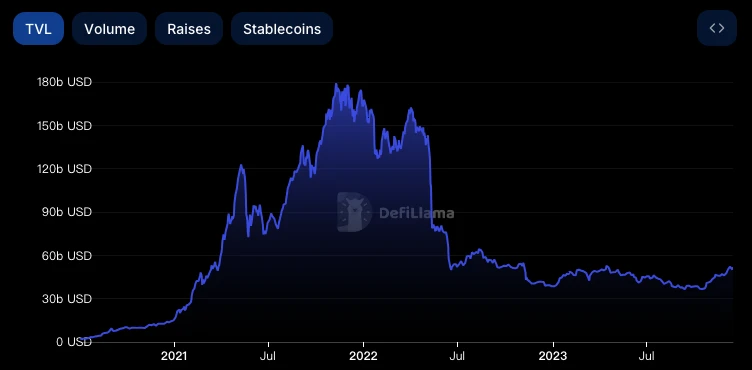Produced by - Odaily Editorial Department
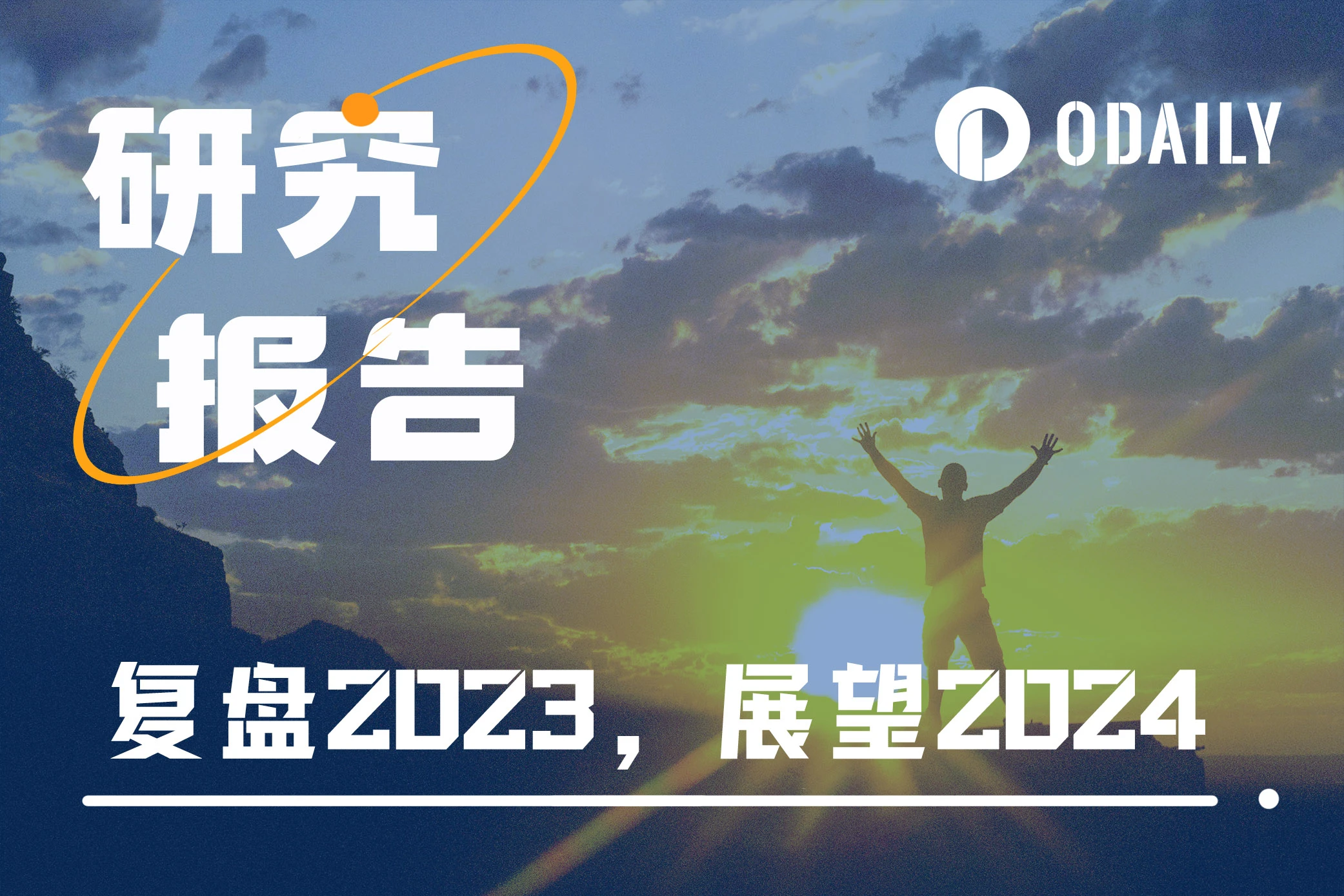
2023 is a year when times change rapidly and differentiation intensifies.
The old smoke has not yet been extinguished, and new wars have begun. Technological blockade and economic repression are intensifying.
AI represented by ChatGPT has begun large-scale commercial use, and accelerationists and technological pessimists are arguing on the eve of what may be the most significant innovative change in mankind. The dispute between the two social giants Musk and Zuckerberg ended online. At the same time, phenomenal culture, entertainment, fashion, and consumer products around the world are all lacking. All of the above seem to be the inevitable result of the in-depth development of multiple values.
Under the demographic structure and macroeconomic changes, real estate, (mobile) Internet... industries that once supported the rapid growth of GDP have lost their luster, and industries such as smart manufacturing, AI, materials, and energy are on the rise. People in this land finally returned to normal offline life and tried to catch up on the lost years, but they had to bear the impact of large-scale corporate layoffs and cost reductions.
Focusing on the Web3 field, under the background of differentiation and transformation, small actions are constantly being taken to bridge the gaps and survive for the fittest.
In terms of linkage with the outside world, the progress of BTC spot ETF is accelerating, and the benefits of large funds entering the market are constantly being digested; the adoption rate of Crypto as a payment method is steadily increasing; Worldcoin collected more than 2.53 million iris information in more than 130 days; the U.S. debt borrowing channel performed well RWA couples DeFi; CZ disarms, and other compliance participants will follow Binance through the turbulent regulatory river in the future; when crypto companies confront US supervision, Hong Kong continues to release benefits; SBF is convicted, and the mess left in 2022 is being dealt with Gradually cleaning up; and the bankruptcy of Silicon Valley Bank and the de-anchoring of stable coins such as USDC, let us re-examine the risk distance between traditional finance and crypto finance.
Bitcoin ecological renaissance, asset issuance methods and protocol standards are changing again, and the new narrative returns to the oldest public chain with strong consensus; the wind of inscriptions and memes is blowing to multiple chains, and innovators are holding the name Fairness Pass, trying to redistribute benefits. Ethereum, which has completed the Shapella upgrade, bids farewell to mining and opens staking withdrawals. Lido, the leader of LSD, has become the king of DeFi TVL; EVM maintains its foundation of legitimacy, and new and old L2 enter the bottom-level competition.
In terms of applications, there will be no midsummer in 2023. DeFi, NFT, and GameFi have low-frequency micro-innovations and stable patterns. Only the Blur+Blend+Blast family can barely stir up the spring water. Fortunately, AI+Crypto takes over and is in social networking, QA, and data. Implement integrated applications in , trading and other directions.
This is also the year when people question narratives, understand narratives, and become narratives. Critics, observers, and builders grabbed the baton and twisted the three sets of melody variations into a 2023 version of Web3 symphonic poem.
In this long report, Odaily will look back at 2023 with you and predict 2024 from the perspectives of major event review, data interpretation, industry review, etc., from the macro market to the micro track.
Click here to download PDF version。
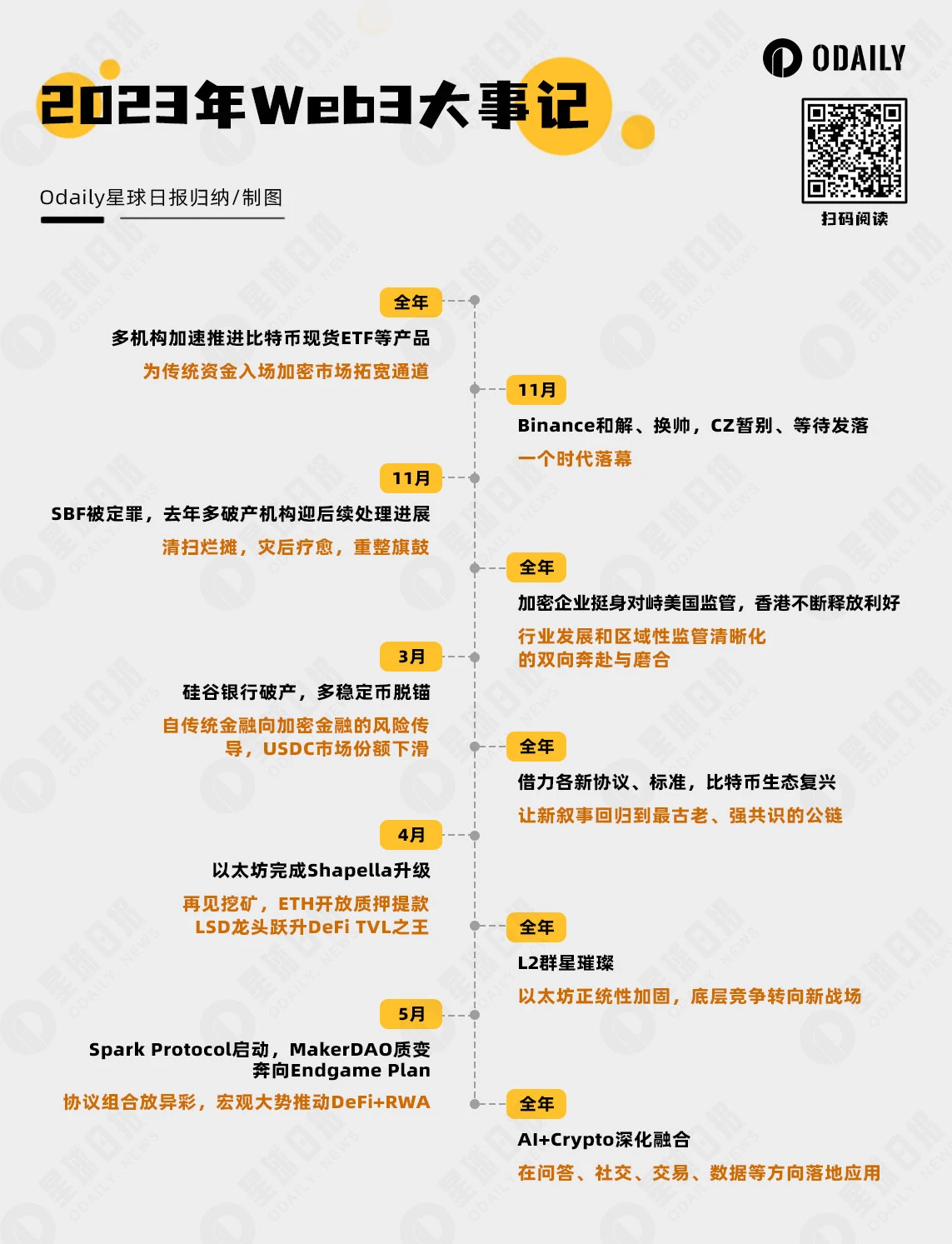
Regulatory policy: The United States suppresses it hard, but Hong Kong makes great strides forward
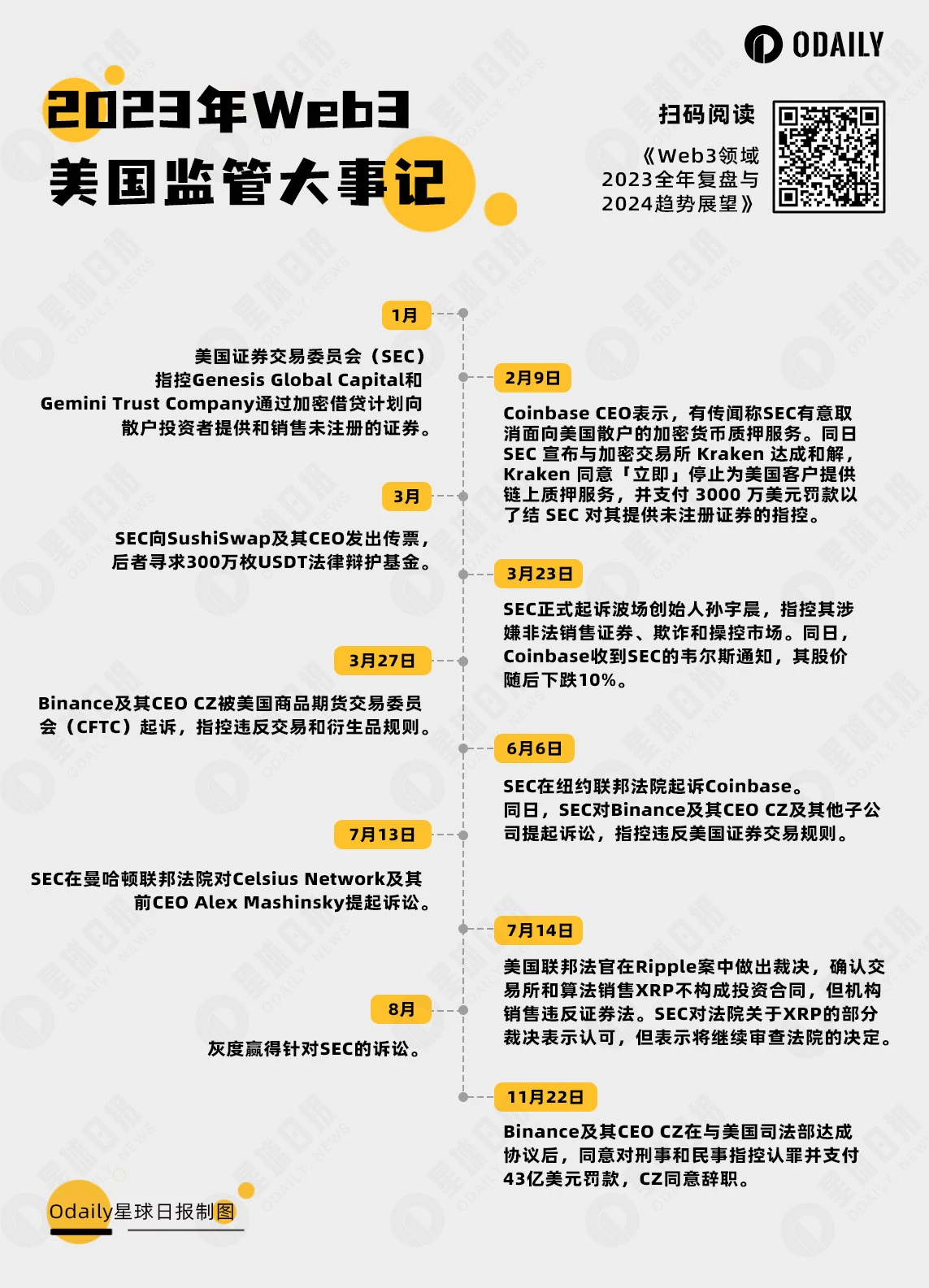
In 2023, other regulatory agencies, such as the U.S. Securities and Exchange Commission (SEC) and the Department of Justice, adopted stricter regulatory measures on the cryptocurrency industry in general.
From Genesis Global Capital and Gemini Trust Company’s crypto lending schemes, to actions against Kraken and SushiSwap, to the indictment of Tron founder Justin Sun, and legal actions against Coinbase and Binance, these events highlight the US regulators’ attitude towards crypto. The harsh attitude of the market in its Wild West state,Committed to making the entire industry more standardized.
In particular, large exchanges such as Coinbase and Binance, which have embraced regulation, have not been spared, showing that regulators are not just focusing on small or fringe companies, but are conducting a comprehensive review of the entire industry.
When cryptocurrencies are heading into a bull market, pressure from large corporate legal teams, legislative bodies, and public opinion prevents regulatory pressure from being fully released, because everyone benefits from it; while during a bear market, regulators can use events such as FTX as a reason to Take a hands-off approach to supervision.
However, from another perspective, these legal actions and rulings in 2023 alsoBringing a level of clarity and certainty to the cryptocurrency industry.
For example, the ruling in the Ripple case provides a clearer legal status for digital assets such as XRP, while the lawsuit won by Grayscale shows some successful legal challenges. Additionally, the agreement that Binance and its CEO CZ reached with the U.S. Department of Justice shows that when cryptocurrency companies work with regulators, paths can be found to resolve disputes. This gradual clarity of the regulatory environment is a positive sign for cryptocurrency companies, indicating that they no longer need to operate on tenterhooks and can instead develop their businesses within a clearer and more stable legal framework.
Despite the challenges, the cryptocurrency industry appears to be moving in a more mature and stable direction after experiencing this series of legal and regulatory events.
On this side of the ocean, Hong Kong, once an important financial hub between the East and the West, has opened its arms to Web3.
Chief Executive Lee Ka-chiu, Financial Secretary Paul Chan and others have frequently spoken out on behalf of the Hong Kong government, high-profile support for the implementation of Web3 in Hong Kong, and attracted encryption companies and talents from all over the world to build it. In terms of policy support, Hong Kong has introduced a licensing system for virtual asset service providers, allowing retail investors to trade cryptocurrencies, launched the Web3 Hub Ecological Fund with a scale of tens of millions of dollars, and plans to invest more than HK$700 million to accelerate the development of the digital economy and promote the development of the virtual asset industry. A Web3.0 development task force has also been established.
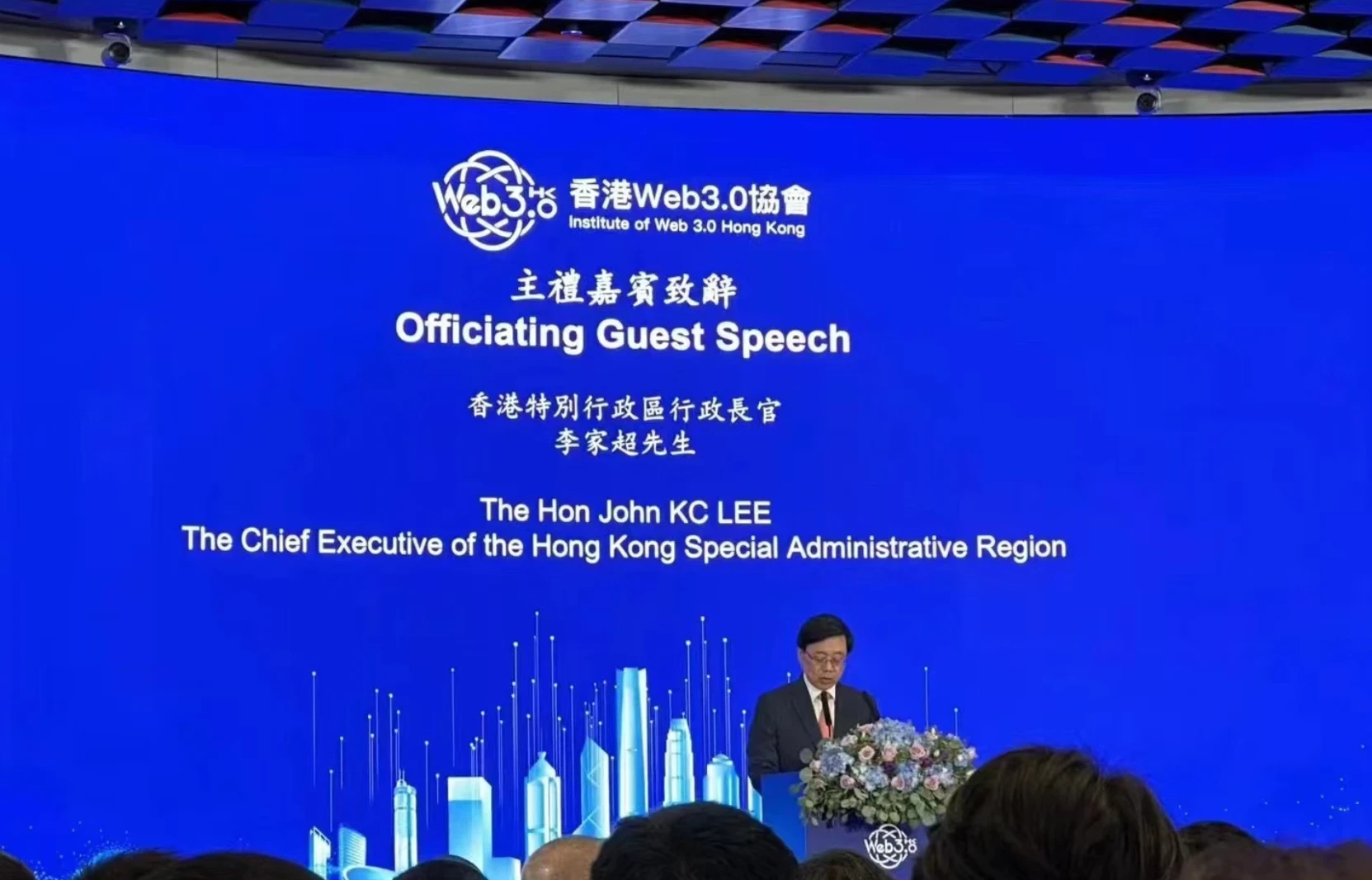
In terms of financial institutions, the first batch of HKD 800 million tokenized green bonds was successfully sold. Compliance representative Hashkey Exchange steadily promoted the opening of products and services and planned to issue the platform currency HSK. Cryptogroup BGX invested in another licensed exchange OSL. Futu has cooperated with Victory Securities to provide BTC and ETH trading services to Hong Kong retail customers. PantherTrade, Futu’s virtual asset trading platform, has submitted a license application to the Hong Kong Securities and Futures Commission. A number of virtual banks, insurance companies, etc. have also reached cooperation with the trading platform.
While making rapid progress, risky events are also taking advantage of the momentum. The unlicensed crypto exchange JPEX was involved in a case involving more than 1 billion Hong Kong dollars, the HOUNAX fraud case involved an amount of over 100 million yuan, and HongKongDAO and BitCuped were suspected of virtual asset fraud... These vicious incidents have attracted great attention from the Hong Kong Securities Regulatory Commission and the police. The Securities and Futures Commission of Hong Kong stated that it will formulate risk assessment criteria for virtual asset cases with the police and conduct information exchanges on a weekly basis.
Outside the United States and Hong Kong:In January, South Korea allowed the issuance of security tokens; in August, Europe’s first spot Bitcoin ETF (Jacobi FT Wilshire Bitcoin ETF) was launched; in September, the Japanese government allowed start-ups to raise funds in cryptocurrency; in October, the G20 The leaders issued a joint communique and unanimously adopted a cryptocurrency regulatory roadmap; while Singapore plans to ban cryptocurrency margin or leverage trading in mid-2024 to curb retail speculation.
Secondary market: repair, accumulation, internal structure transformation
In 2023, the market will gradually emerge from the deep bear, and gradually usher in the Indian Summer from the crypto winter after the FTX thunderstorm incident.
Overall, Coingecko data shows that the total market value of the crypto market at the beginning of the year was approximately US$831.7 billion. Since then, it has been rising. As of December 12, the total market value has exceeded US$1.62 trillion, which has almost doubled compared with the beginning of the year and is approaching the global market value. The fourth largest company – Alphabet ($1.67 trillion).

During the critical period of bull-bear transition, the total market capitalization ratio of BTC and ETH has also undergone major changes: Bitcoin has risen from 38.31% at the beginning of the year to 49.5% today; ETH has risen from 17.45% at the beginning of the year to more than 18% , and then fell back to 16.2% today, failing to keep up with BTC’s gold-absorbing pace.
In terms of price, Bitcoin gradually rose from US$16,615 at the beginning of the year, breaking through US$20,000 on January 14, and US$30,000 on April 11. After half a year of adjustment, it broke through US$30,000 again on October 22. It officially broke through the US$40,000 mark on December 3, and was trading at US$41,890 on December 12, which was 2.5 times the price at the beginning of the year. ETH also gradually broke through from US$1,200 at the beginning of the year, breaking through US$2,000 on April 13. Since then, it has been fluctuating in the range of US$1,500 to US$2,000. By December, the price remained above US$2,000. , reported $2,232 on December 12, an increase of 86% from the beginning of the year.
Among the top 100 tokens by market value at the end of the year, most of them benefited from Xiaoyangchun and experienced sharp rises; only a small number of tokens such as SUI, BLUR, APE, CAKE, ALGO, etc. fell.
Among the top twenty tokens by market capitalization, the following three tokens have experienced larger increases:
1. Solana (SOL), mainly benefiting from news such as FTX’s restart, has grown from US$9.97 at the beginning of the year to US$66 now, with a growth rate of 579.57%, and its current market value ranks 6th;
2. Chainlink (LINK), the income encryption market has recovered, rising from US$5.62 at the beginning of the year to now trading at US$14.17, with a growth rate of 154.46%, and the current market value ranks 14th;
3. Bitcoin Cash (BCH), affected by the popularity of Bitcoin, has risen from US$95.96 at the beginning of the year to US$227.48 now, with a growth rate of 134.33%, and the current market value ranks 19th;
also,Concepts related to L2 are hot this year.According to statistics from Coingecko, the total market value of L2 tokens now reaches US$16.78 billion. The top five are Polygon (US$7.89 billion), Immutable (US$2.6 billion), Optimism (US$1.95 billion), and Mantle (US$1.786 billion). ), Arbitrum ($1.45 billion), among which tokens such as IMX and OP have experienced annual growth of more than 80%.
Modular blockchain aspects, the current leading project Celestia has launched the main network at the end of October, and the token TIA has increased by 188% in one month.
AI aspect, with the release of ChatGPT at the end of last year, 2023 can be called the first year of AI large model application. AI-related concept tokens have benefited from this and have generally seen higher gains this year. High market capitalization representatives of this concept are Bittensor ($1.785 billion) and Render ($1.498 billion), with gains of 178% and 734% respectively. In July, OpenAI CEO Sam Altman’s crypto startup project Worldcoin officially issued coins. When the currency was issued, the price was around US$2. It bottomed out at around US$1 in September, then rose slowly, and is now quoted at US$2.38.
In terms of platform currency,Coingecko statistics show that as of December 12, the total market value of platform coins is US$65.321 billion, of which the top five are: BNB (US$37.962 billion), UNI (US$4.58 billion), OKB (US$3.605 billion), LEO (3.449 billion) billion) and CRO ($2.584 billion). The platform coins with larger gains this year are: RUNE (297.61%), BGB (168.79%) and OKB (117.03%). It is worth mentioning that FTT, which collapsed last year, has increased significantly this year due to news related to the restart of FTX, with a year-to-date increase of 246.49%.
In terms of stablecoins,As of December 12, the total market capitalization of stablecoins reached $129.8 billion, accounting for 8.0% of the total crypto market capitalization. In terms of market size, currently USDT (USD 90.5 billion), USDC (USD 24 billion), DAI (USD 5.28 billion), TUSD (USD 2.6 billion) and BUSD (USD 1.47 billion) basically occupy the majority of the stablecoin market. share. Compared with last year, when Tether, USDC and BUSD were competing against each other, the market shares of USDC and BUSD have declined significantly this year.
In March 2023, a major incident occurred between Circle, the issuer of USDC, and Silicon Valley Bank (SVB). The $3.3 billion Circle held at Silicon Valley Bank was at risk as it suffered a liquidity crisis and a run on customer funds. This caused Circle’s stablecoin USDC to fluctuate in price and break away from its peg. Circle is closely connected to the U.S. banking system, and the bankruptcy of Silicon Valley Bank seriously affected its credibility, which in turn led to a significant reduction in the circulation of USDC. Circle and rival Tether have both invested their stablecoin reserves ($24 billion and $87 billion, respectively) in assets such as U.S. Treasuries to earn income, but USDC’s declining market share has left Circle facing a tougher IPO challenge. As a result, the market value of USDC has decreased significantly, from US$44 billion in January to US$24.5 billion at the end of November, a decrease of approximately 44.32%.

In February, the U.S. Securities and Exchange Commission (SEC) issued a Wells notice to the stablecoin company Paxos, indicating that it may file a lawsuit on the grounds that the Binance USD (BUSD) issued and listed by Paxos is considered an unregistered security. On the same day, the New York State Department of Financial Services (NYDFS) directed Paxos to stop minting new BUSD. Paxos announced that it will stop issuing new BUSD tokens as of February 21, but will continue to support the product to ensure redemption until at least February 2024. CZ believes that the SEC’s consideration of BUSD as an unregistered security could have a profound impact on the crypto industry and expects users to gradually switch to other stablecoins. There is also speculation that the SEC’s crackdown on BUSD may be related to its deposit-based interest-earning products, or to the broader category of “securities.” Since then, BUSD has seen a significant decline in market capitalization, from $16 billion at the beginning of the year to around $1.69 billion today. In November, Binance announced that it would be removing BUSD and exchanging BUSD for FDUSD.
Different from the above two, the market value of USDT has increased significantly due to users abandoning other stablecoins and turning to Tether, gradually rising from US$66 billion at the beginning of the year to US$90.5 billion at the end of November, with a growth rate of 37.12%. At the same time, PayPal’s PYUSD and Aave’s stablecoin GHO also appeared during the year, making the stablecoin ecosystem more diverse.
Primary market: Total financing exceeds US$7.4 billion, looking to rebound at a trough
According to incomplete statistics from Odaily, as of November 25, the encryption industry has publicly disclosed 1,023 investment and financing events in 2023, a year-on-year decrease of 38.3%. The total announced financing amount is approximately US$7.44 billion, a year-on-year decrease of 78.74%.
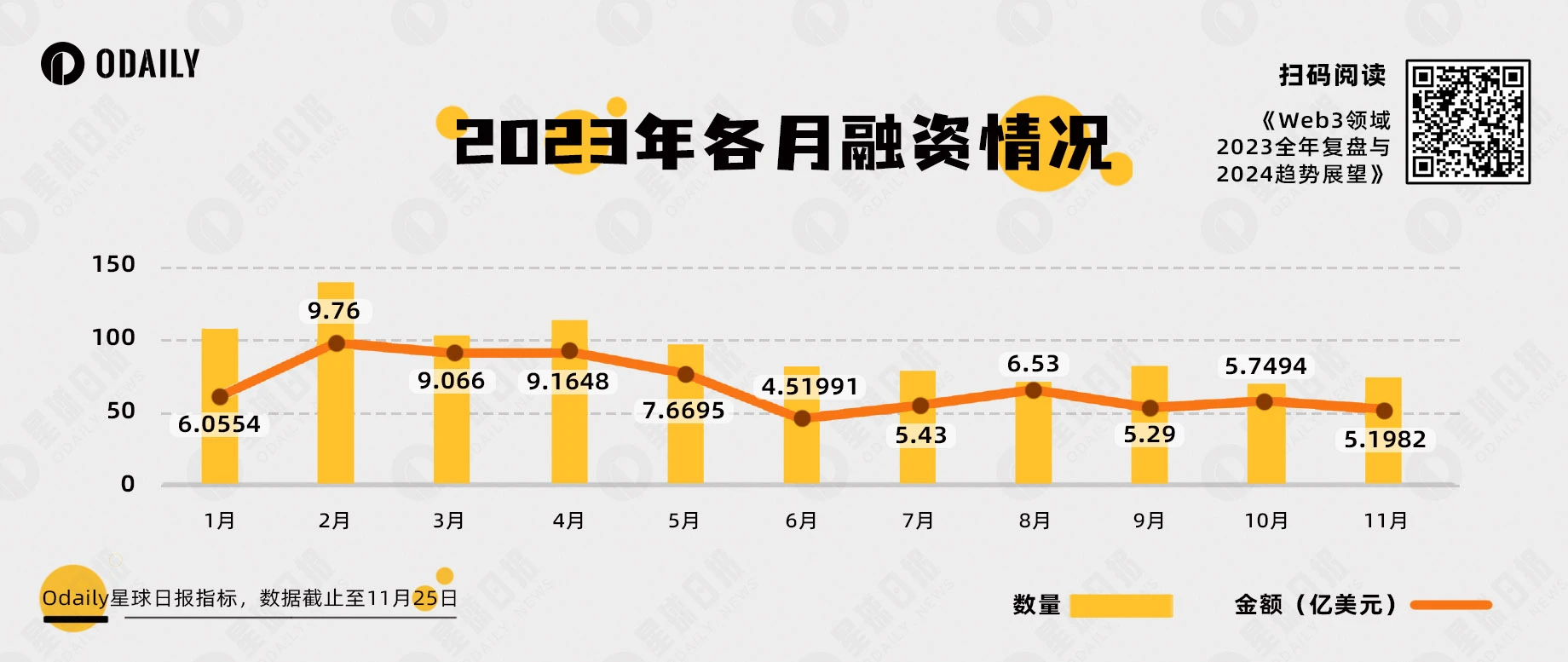
Number and amount of financing from January to November 2023
Web3 primary market financing in 2023: In terms of quantity, the average monthly number is nearly 100, which is generally balanced but declining; from the perspective of financing amount, the first 5 months are higher than the last 6 months.
Looking at the primary market financing projects in 2023, Odaily classified all projects that disclosed financing into five major tracks based on the business type, service objects, business models and other dimensions of the invested projects - infrastructure, applications, technical service providers, and financial services. and other service providers, and further identifies subdivisions such as DeFi, underlying facilities, GameFi, CeFi, tools, NFT and Layer 1.
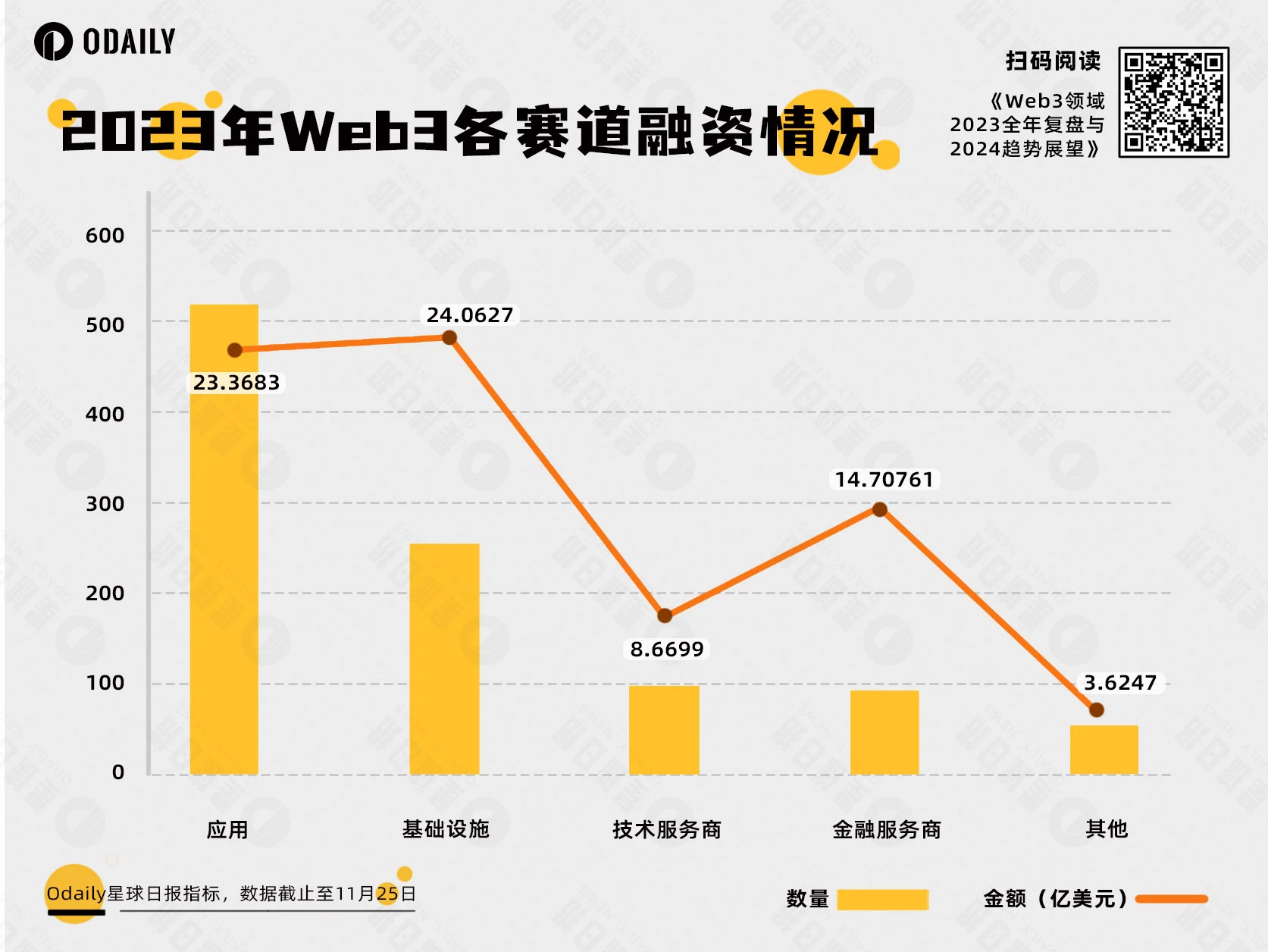
As can be seen from the above figure, the popular financing track in 2023 falls on applications, with the number of financings throughout the year exceeding 500. This also indicatesThe development of Web3 infrastructure is slowing down, and the industry is in urgent need of fat applications with the potential for large-scale adoption.
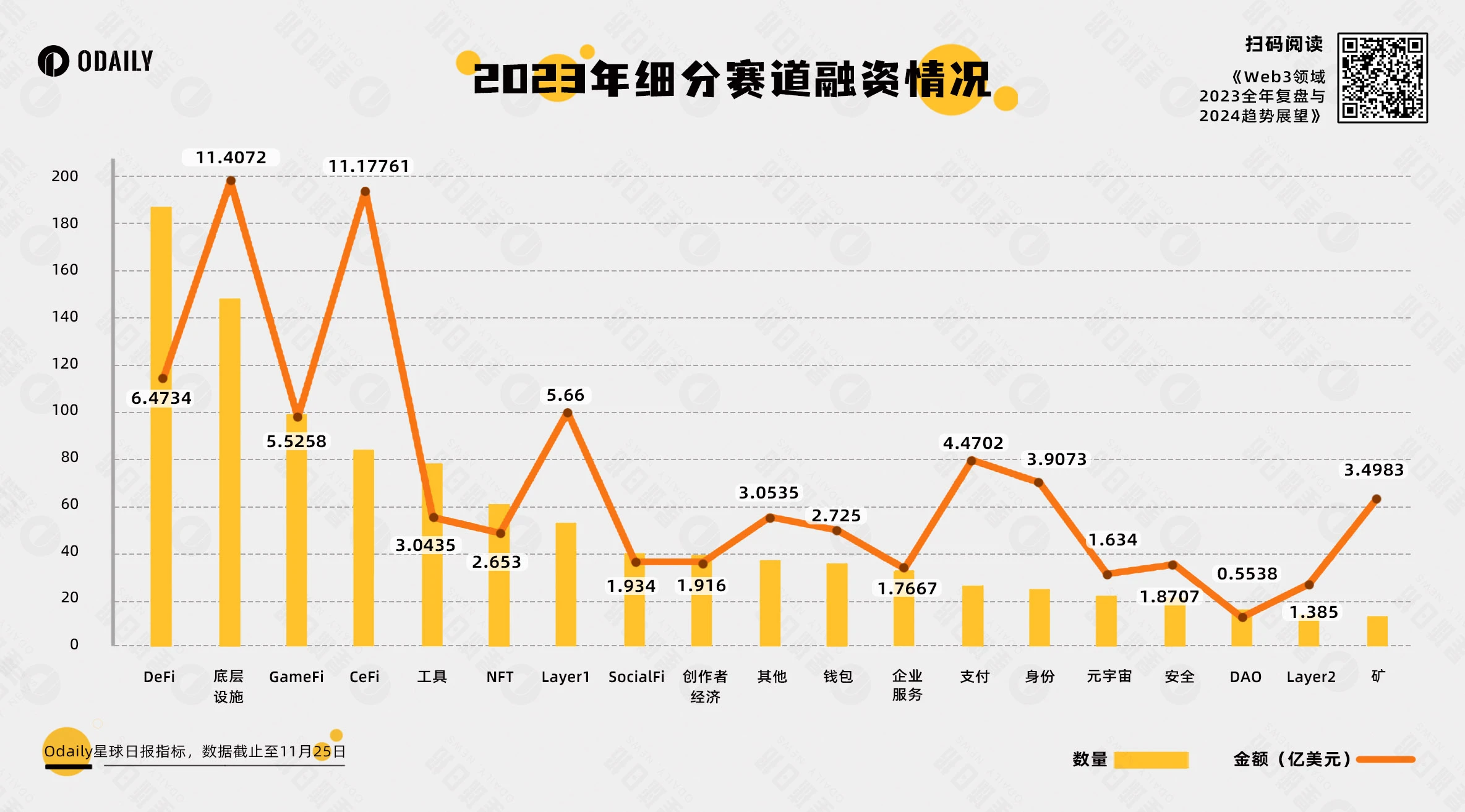
fromFinancing quantity by segmentJudging from the above, the DeFi sector ranked first among the sub-sectors throughout the year with 187 financings. Among them, trading platforms serving institutions and order book-based DEX based on high-performance blockchain are emerging.
Secondly, as a sector favored by capital all year round, underlying facilities have also received 148 financings. At the same time, more underlying facilities projects are also actively serving traditional fields, and the profit channels are more diversified.
The GameFi and CeFi sectors followed, with 99 and 84 funding rounds respectively. GameFi has always been at the forefront of accepting Web3 newcomers due to its playability and rate of return. In the past two years, the number of GameFi project financings has ranked among the best. Perhaps for capital, GameFis return cycle is shorter.
Some new models have also emerged in the segmented sectors, such as Telegram Bot, portal entry-level platform, and AI+. The rise of Telegram Bot and application portal platforms provide new users with an easy-to-use Web3 entrance; the rise of AI+ projects benefits from the rapid development of the AI field.
During the bear market stage, capital moves are more cautious.The number of projects with financing amounts exceeding 10 million US dollars was approximately 200, a year-on-year decrease of 58.68%.But there are also projects with financing amounts exceeding RMB 100 million.
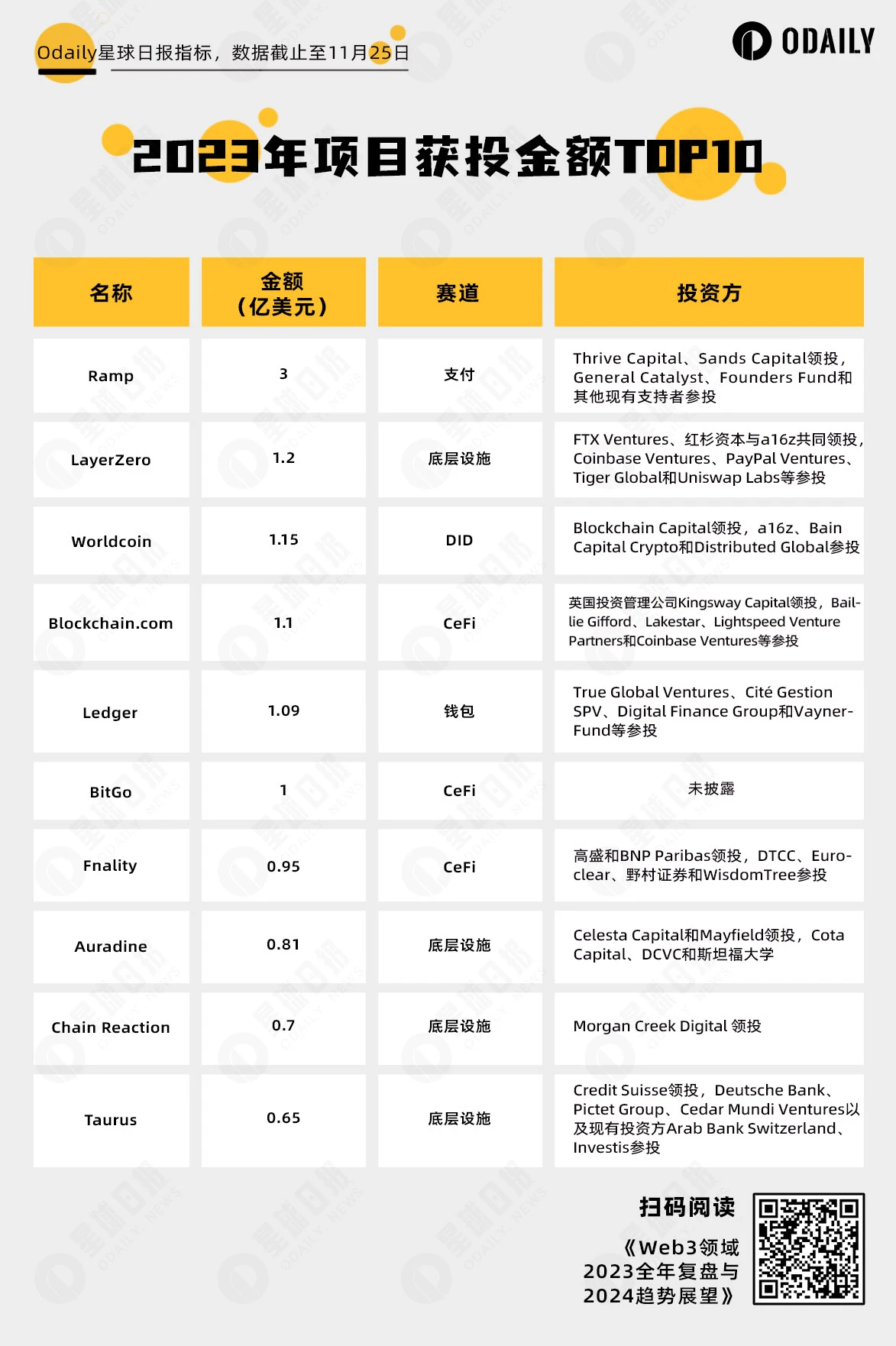
Top 10 investment amount in 2023
Ramp, LayerZero and Worldcoin are the top three in terms of investment amount this year:
Ramp mainly serves the legal currency payment channel between the encryption market and the traditional financial market, and provides infrastructure for the introduction of Web3 funds.
As the underlying infrastructure, LayerZero has won the favor of well-known Web3 institutions such as a16z and Coinbase Ventures, as well as traditional institutions such as Sequoia Capital and PayPal Ventures.
With its team background and unique technology future value setting, Worldcoin has attracted attention and pursuit in the encryption market. As a new leader in the DID track, Worldcoin has made the public look forward to the integration of the identity system and Web3 in the AI era.
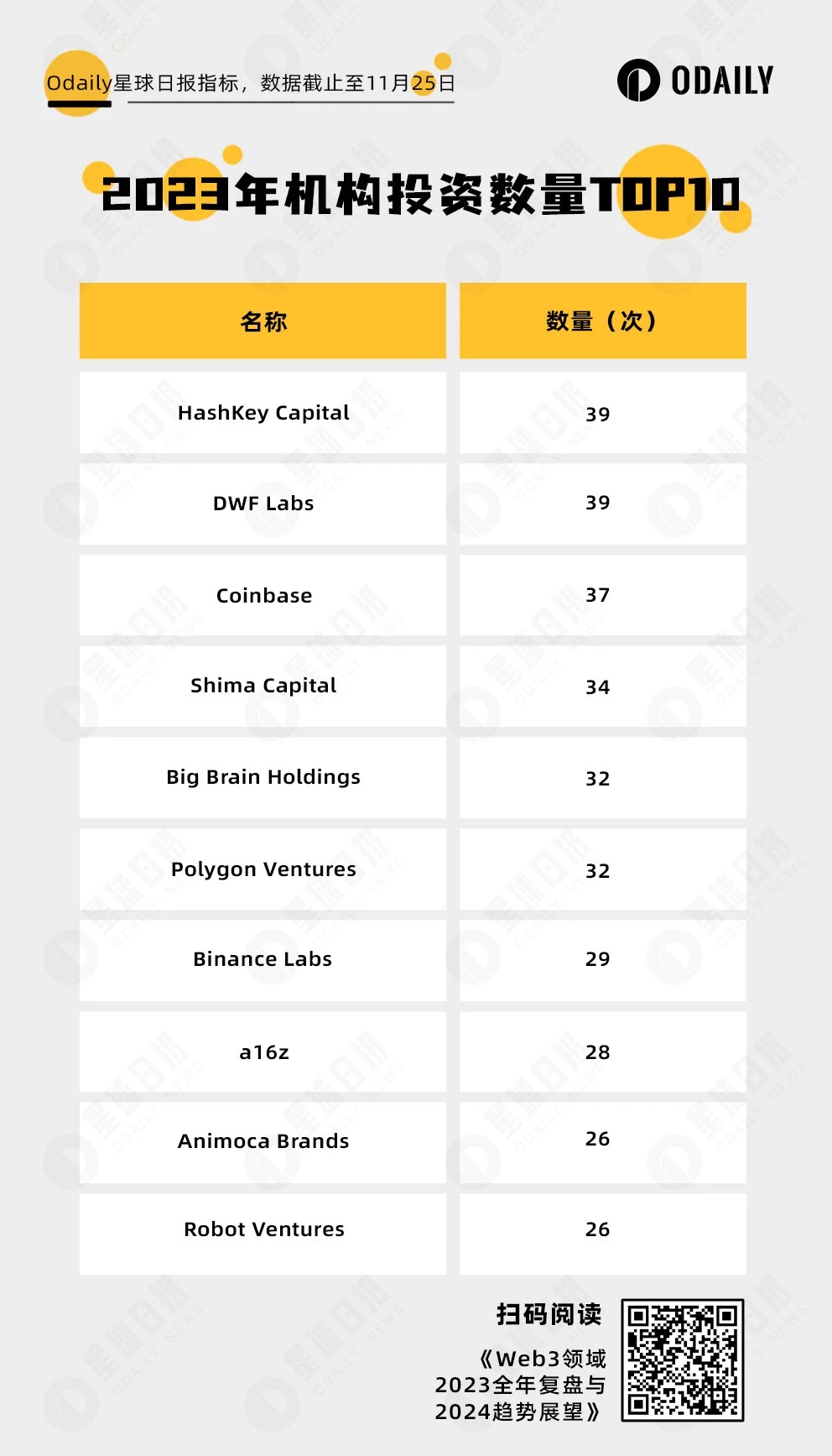
As can be seen in the chart above, HashKey Capital and DWF Labs tied for first place in the number of transactions made this year. In terms of preferences, infrastructure and DeFi account for nearly two-thirds of HashKey Capital’s investments this year. DWF Labs, which has attracted attention for its market-making style and vertical business model, focuses on the Layer 1 and GameFi tracks (17 transactions in total).
At the same time, we also see many institutions that were on the list last year, such as a16z, Animoca Brands, Shima Capital, and Coinbase. Although the number of projects has dropped significantly compared to last year, the projects they invested are still attracting attention, such as Worldcoin, LayerZero, YGG, etc.
Finally, although some institutions did not make the list, they still achieved outstanding results. For example, Paradigm only made 6 public attempts throughout the year, but Friend.tech, Blast and Flashbots received extremely high attention.
In general,Compared with last year, primary market financing in 2023 will decline seriously in terms of quantity and amount.This is somewhat inseparable from the fact that the secondary market is in a bear market stage. But the trough has been formed, and a rebound may come next year. The organization that planted the seeds will also see the seedlings grow into trees.
Bitcoin: The two forces of ecology from the bottom up and capital from the outside to the inside
On January 30, the “Ordinals” protocol created by Casey Rodarmor was officially launched on the Bitcoin mainnet, opening the way for a magnificent wave of Bitcoin ecological innovation in 2023.
Initially, Ordinals focused on NFT projects and developed the concept of sub10K (the inscription of the first 10,000 serial numbers). At this time, the projects were all kinds of weird, and they were basically created by community members themselves.
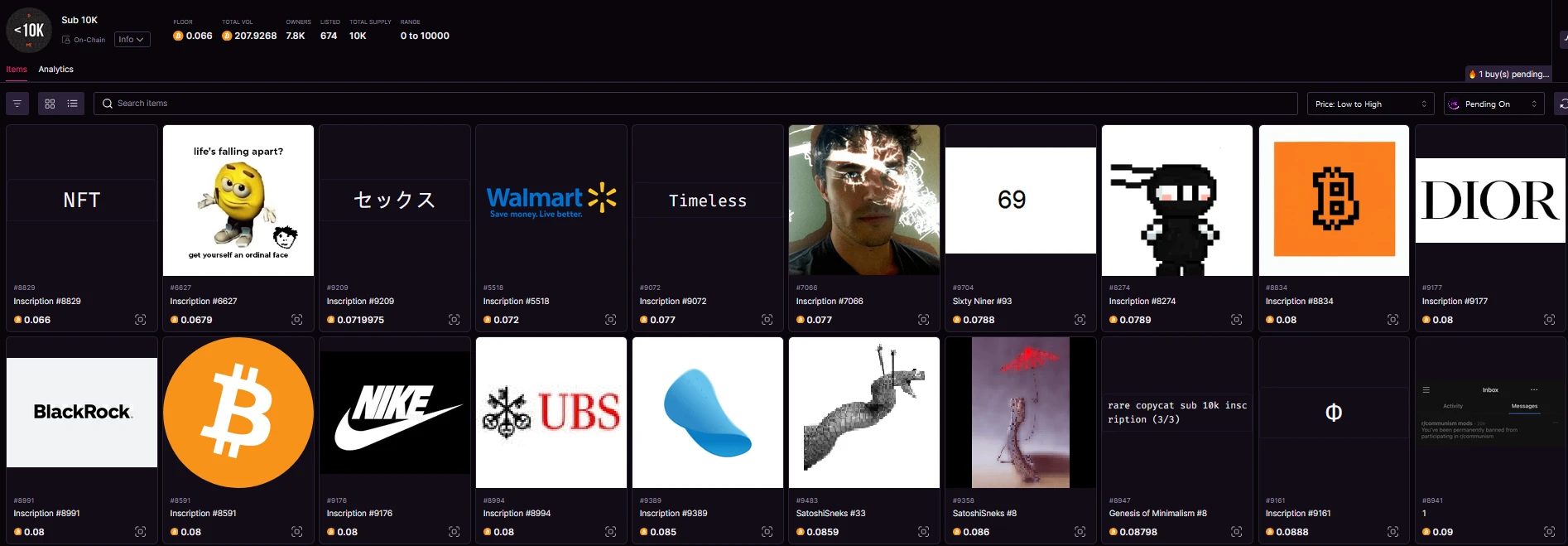
Subsequently, Yuga Labs released the TwelveFold series as an early regular army. Yuga Labs explores the relationship between time, mathematics and variability for the TwelveFold series. Unlike PFPs like BAYC, the pieces that make up the TwelveFold collection are produced in-house by Yuga Labs’ art team using 3D modeling, algorithmic construction and high-end rendering tools,To pay tribute to the serial number inscriptions currently completed by hand。
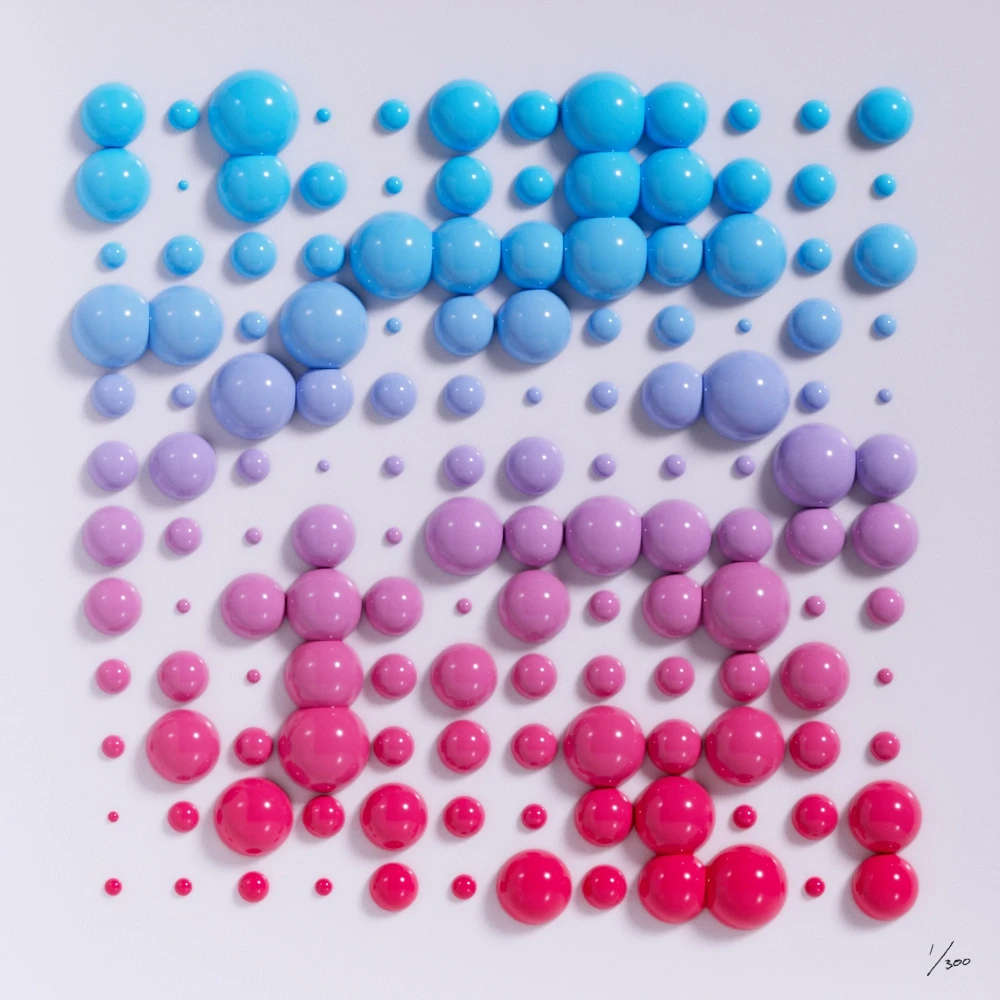
The series of Bitcoin NFTs initially focused on transporting NFT series from other chains. For example, Ordinal Punks and Bitcoin Punks used images of Ethereum CryptoPunks. NFTs in this era are also very simple. The validity check of Bitcoin Punks is through the development team to compare pictures and whether the hash is first launched.Check one by onederived.
At this time, the waves formed between gentle waves, and then,BRC-20 craze is coming。
A token standard proposed by Domo on March 9, engraved a specific text on Bitcoin and regarded it as a token, and the first BRC-20 token ORDI was born. Ecological participants then deployed ownerless community tokens such as meme, punk, and pepe.sats was also born on March 9th.
In March, the BRC-20 token did not attract much attention and was mainly traded through OTC. At the end of April, the ORDI price reached 1 U, which began to drive a series of BRC-20 increases. At this time, the mainstream trading varieties were still established and established spontaneously by the community. Spread, such as the aforementioned meme, punk, etc., Ordinals founder concept domo, complete combination concept nals, etc.
Subsequently, ORDI rose above 4 U, BRC-20 became more and more popular, and various tokens with project parties began to be born, such as IDO platform TURT, game concept ORDZ, etc.
At the same time, some X platform Vs also began to participate.XEN founder Jack LevinRelated tokens include PUSY, EPIC, DRAC, etc., which were finally publicly issuedVMPX, causing the transaction fees on the Bitcoin network to soar to more than 400 sats/byte. Similarly, a user named BitGod became popular through a series of operations, and the token OXBT he promoted became the most popular BRC-20 for a time.
Extreme FOMO also heralds the arrival of an inflection point.On May 8, Gate.io announced the launch of ORDI, which rose to a maximum of 29.5 USDT and closed at 17.8 USDT that day. Because the network on the chain was too congested, it was difficult for users to place orders. After the existing orders were cleared, the ORDI on Unisat once exceeded 30 USDT. On May 20, OKX announced the launch of ORDI. ORDI rose to a maximum of 17.1 USDT and closed at 12.5 USDT.

BRC-20 Second Spring starts on September 25,BRC-20 token sats minting completed, the total number of castings reached 21, 107, 258 times, the number of holders reached 36, 061, and the casting started on March 9, 2023, which took a total of 6 months and cost more than $20 million to cast.And this day,Monsters from Corsica landed in Port Joan,ORDI closed at 3.6 USDT.
October 30,Bitcoin inscription wallet UniSat Wallet issued a statement., decided to include 14 inscription assets into the first batch of support lists for the brc 20-swap mainnet, including sats, ordi, oxbt, meme, vmpx, pepe, etc.
In early November, sats rose all the way, which once again triggered the popularity of BRC-20. The concept of zoo began to rise, and a series of animal tokens including rats, cats, bears, etc. began to occupy the top of the trading list.
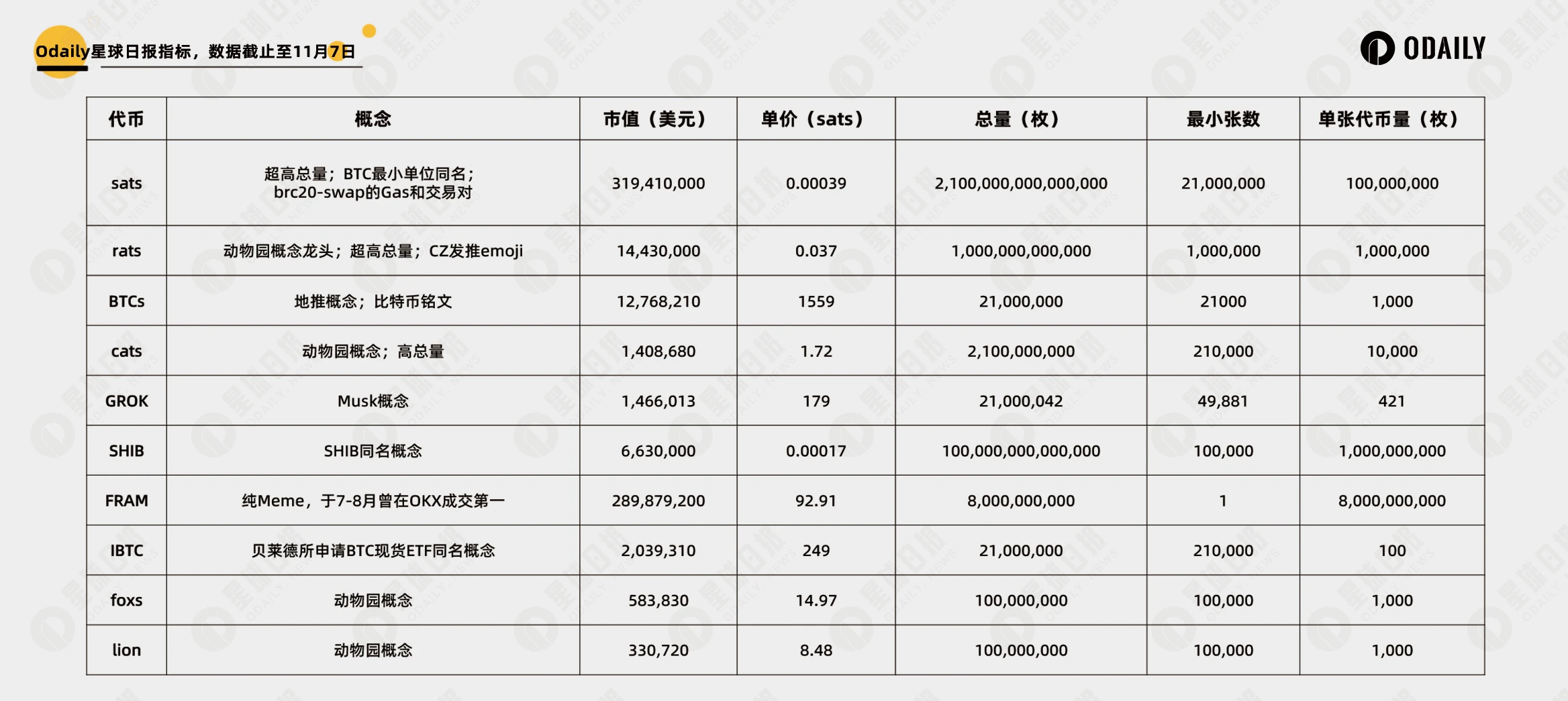
His Majesty the Sovereign Emperor arrived in his faithful Paris on November 7th:As Binance launched ORDI, ORDI also began to recover its lost ground, rising to a maximum of 27.8 USDT on November 24, becoming the BRC-20 token with the largest market capitalization again. On December 7, ORDI hit an all-time high of 69.7 USDT, with a market value of over US$1 billion.
November 16,Bitcoin network regular transaction fees rise to 186 sats/byte. The engraving cost of BRC-20 is getting higher and higher, but it has not stopped the enthusiasm of users. Several high-volume BRC-20s including MMSS, Bear, etc. have all been engraving quickly.
With the vigorous development of BRC-20, various competing product protocols have gradually come into peoples view. The relevant head protocols are as follows:
Taproot Assets(formerly Taro), is a protocol powered by Taproot for issuing assets on the Bitcoin blockchain, creating assets that can be transmitted on the Lightning Network, enabling instant, high-volume, and low-fee transactions.
Atomicals Protocol,Is a simple and flexible protocol for creating, transmitting and updating UTXO blockchains (such as the Bitcoin network)digital object(Traditionally known as NFTs). Unlike Ordinals, which were originally designed for NFTs,It rethinks how to issue tokens on BTC in a centralized, tamper-proof and fair manner from the bottom up.。
BRC-420 ,Introducing an approach to digital asset management in the Metaverse, providing creators with a comprehensive system to manage, share and monetize their creations through recursion, licensing and royalties.
While the native ecosystem of Bitcoin is developing, the external environment has also undergone drastic changes. The application for Bitcoin spot ETF has opened up the road to compliance for Bitcoin. On the other hand, top whales are also vigorously increasing their positions, and their holdings and the corresponding right to speak has further increased.
Back on June 29, 2021,Cathie Wood’s ARK Invest has submitted a Bitcoin ETF application document, after multiple extensions,Officially rejected by SEC in April 2022. Then ARK’s application was rejected for the second time in early 2023, and it applied for a third Bitcoin spot ETF in May. Some asset management companies are not hopeful about the emergence of Bitcoin spot ETFs.During this period, the Bitcoin spot ETF had a modest impact on the market.
Until June 15th,People familiar with the matter said that BlackRock, the largest asset management company, is about to submit an application for a Bitcoin ETF., this news triggered market enthusiasm, and BTC bottomed at 24,800 USDT, becoming the lowest price after June.The bottom of the market. Subsequently, Fidelity, the third largest asset management company, also joined the application queue. After news of Franklin Templetons application broke on Sept. 12,The market has completed its last bottoming,The expected amount of funds of these asset management giants,Making spot ETFs an important factor in Bitcoin’s short- and long-term volatility.
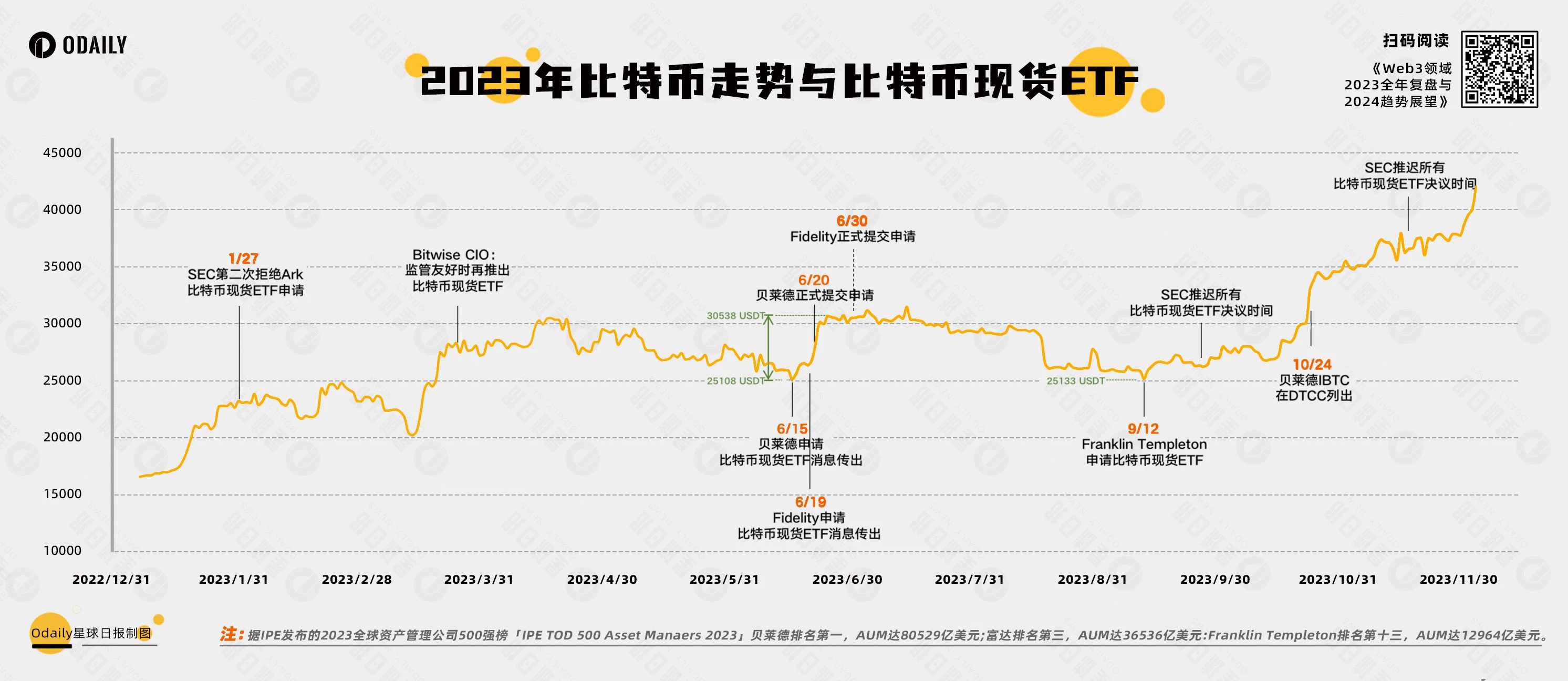
althoughSeptemberandNovember, the SEC has repeatedly postponed its decision on the Bitcoin spot ETF, and on October 16 it was even reportedSEC approves BlackRock’s iShares Bitcoin spot ETFofFalse news, but many people believe thatBitcoin Spot ETF Approval Is Necessary,Its just a matter of when.
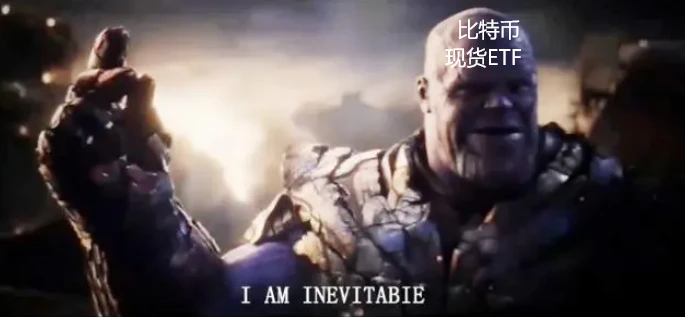
CME, the United States traditional financial participation in crypto options, has seen its open interest in Bitcoin contracts rise all the way, surpassing Binance to rank first, and is close to its historical high in 2021.
andMicroStrategy, as a giant whale representative,As of December 7, a total of 174,530 Bitcoins have been purchased, with a total cost of US$5.28 billion, that is, the average position price is 30,252 USDT. Based on the current price of 44,000 USDT, there has been a floating profit of 2.4 billion. Dollar.
MicroStrategy was once considered a counter-indicator because of its large floating losses. It waited until the market reversed by continuing to add positions, and it is still very optimistic about the future of Bitcoin.MicroStrategy co-founder Michael Saylor participated in an interview with CNBC, its main points include:
Or will continue to buy,You can never say “own too many Bitcoins”;
SEC approval of a Bitcoin spot ETF does not threaten MicroStrategy, which is a differentiated product;
Post-halving selling pressure will drop from $12 billion to $6 billion per year, which is quite optimistic about the next twelve months;
SEC approval of Bitcoin spot ETF expected inThe first quarter of next year, or sometime in the next 12 months.
Ethereum: becoming more mature, bravely facing old opponents and new challenges
As the most important force in the crypto ecosystem, Ethereums performance in 2023 is not satisfactory. In particular, after the completion of the Shapella upgrade (Shanghai+Capella), the Cancun upgrade (Cancun) has been postponed. There has been no major progress in technology, and there is a lack of hot spots for speculation in the news. The currency price has been sluggish, and it was not until the end of the year that it began to rebound with the broader market, but Has been weaker than Bitcoin.
1. Data: Prices are sluggish, and the ETH/BTC exchange rate continues to fall.
Throughout 2023, the price performance of ETH can only be described as bland. It has neither the heroic surge from US$750 to US$4,860 in 2021, nor the thrilling drop from the peak to below US$900 in 2022. .
At the beginning of 2023, ETH started from $1,200 and began to rise following the market, but it always fluctuated around $1,500. It seems that the good and bad things from the outside world cant have much impact on it. It was not until the completion of the Shanghai upgrade in April that the price of ETH briefly broke through 2,000 US dollars, rising to a maximum of around 2,150 US dollars. However, it was unable to continue and slowly fell back, always fluctuating below 2,000 US dollars. It was not until the bull market signal was confirmed at the end of the year that ETH seemed to make up its mind and entered the land of fairyland again, returning to US$2,000 and reaching a maximum of US$2,400, with a cumulative increase of 83% throughout the year.
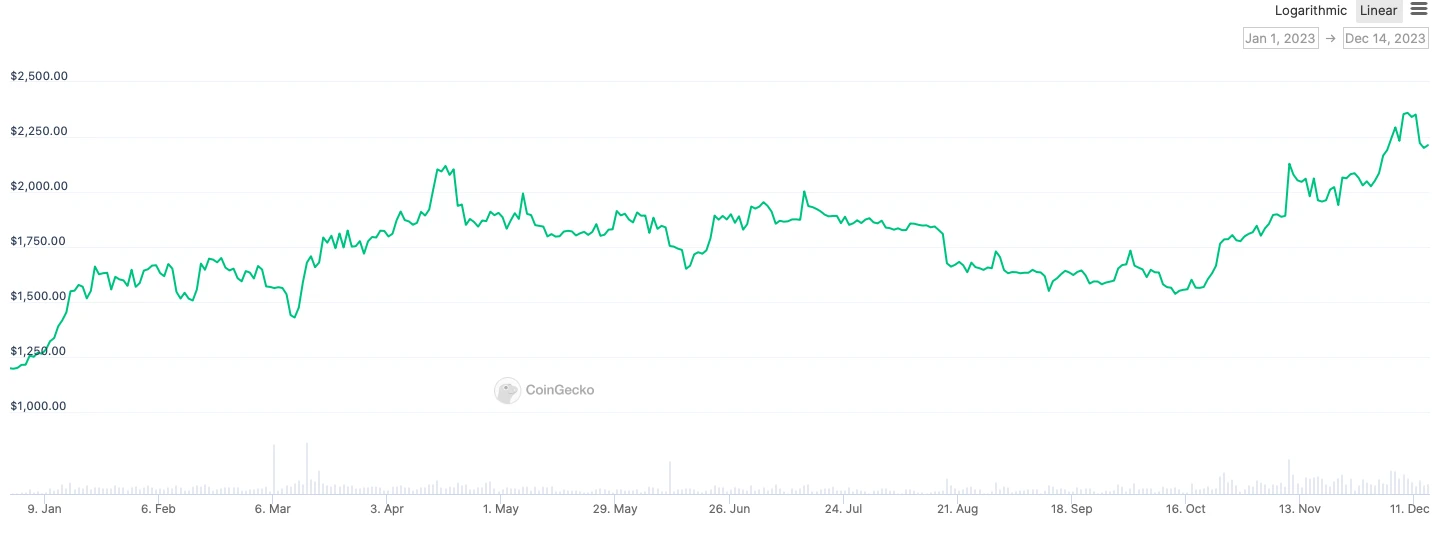
ETH Price Trend
The blandness of ETH is not only reflected in the price, but also in terms of market capitalization share. Throughout this year, ETHs market value has remained around 17% -18%, while BTCs market value has continued to rise during the same period and exceeded 50% at the end of the year. The difference between the two is more obvious through the ETH/BTC exchange rate. The exchange rate has been declining from 0.072 at the beginning of the year, and once fell below 0.05 in December this year, and it has been maintained at around 0.052. Although looking at a larger level, we can see that the ETH/BTC exchange rate has bottomed out, but whether it can stand firm and continue to rise is still worth waiting to see.
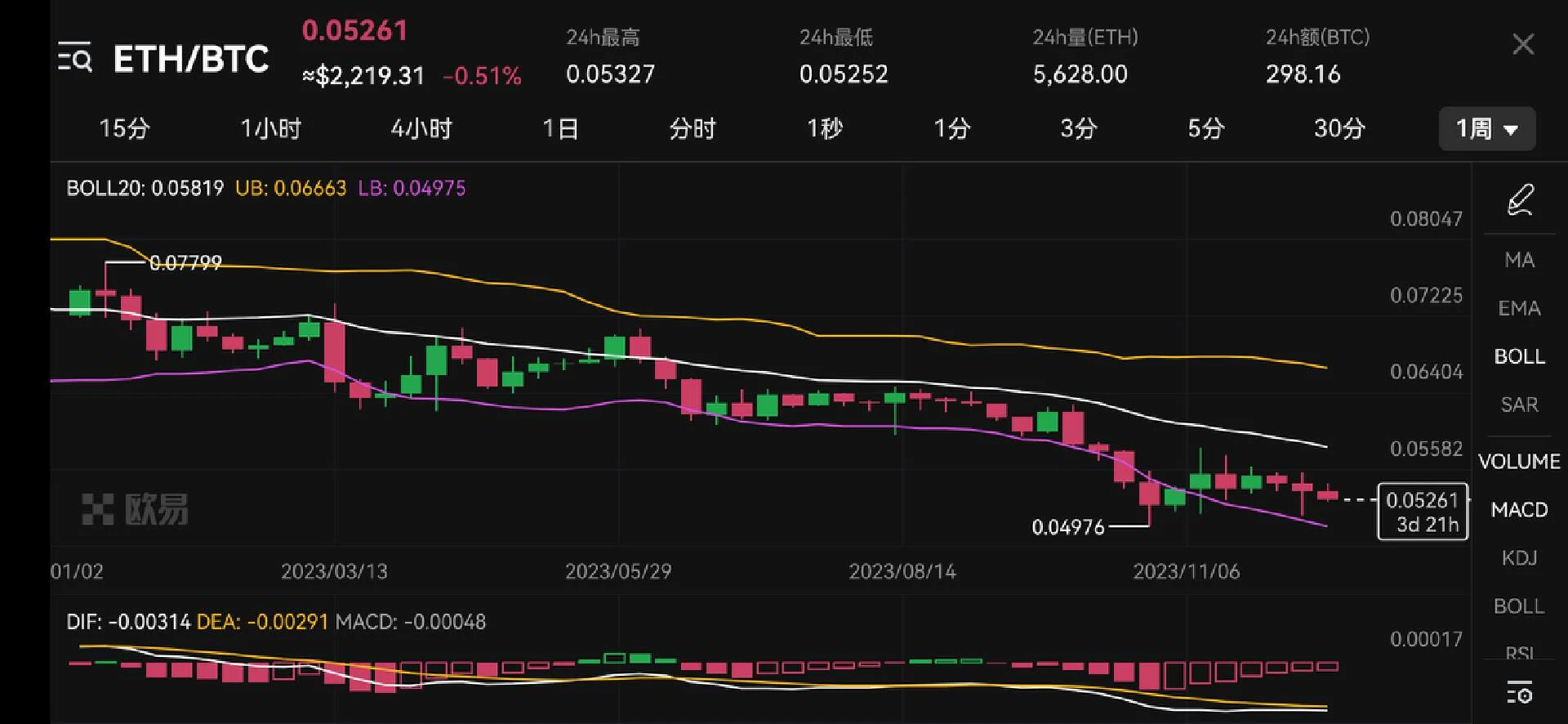
ETH/BTC exchange rate trend, weekly chart
The total lock-up volume (TVL) of Ethereum DeFi has basically increased in line with the price this year, from US$3.4 billion at the beginning of the year to US$6.4 billion at the end of the year, an increase of less than 100%. From a data point of view, due to the overall cold winter in the industry in 2023, Ethereum-based DEX, lending and other sectors have generally cooled down, making the DeFi ecosystem that Ethereum is proud of, no longer growing strongly.
Another thing to note is that the Ethereum LSD (liquidity pledged derivatives) sector became a hot spot in the market in the first quarter of this year and is highly sought after. The reason behind this is: With the transformation of the Ethereum main network from POW to POS, users can pledge 32 ETH as a pledge node. Since ETH pledge brings a reduction in asset liquidity to users, there is a subsequent increase in the demand for collateral. Due to the strong demand for liquidity, LSD services came into being.
However, after the Shanghai upgrade, ETH withdrawals were opened, and the LSD sector quickly cooled down. Except for the top few projects, it was basically difficult for other latecomers to gain market share again. As of now, Lido, a liquid staking solution provider, ranks first among many pledgers, accounting for 31.8%, while Coinbase ranks second with a share of 8.84%, and Stakefish ranks first with a share of 7.3%. Ranked third.
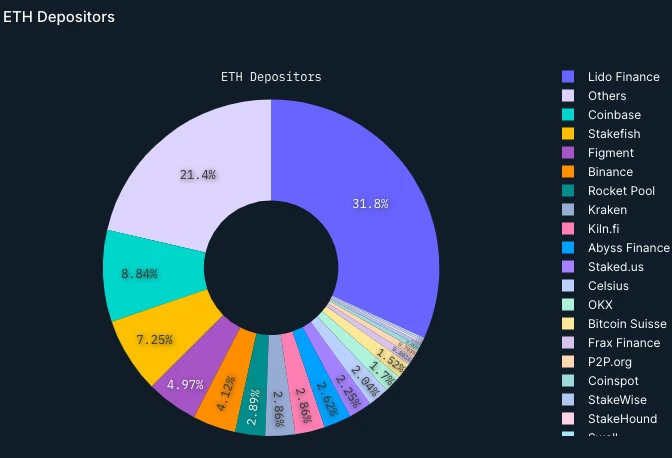
2. Technology: two major upgrades, full of expectations
From a technical perspective, the two biggest events in Ethereum this year are related to upgrades: the Shapella upgrade and the Cancun upgrade.
On April 12, 7 months after the merger upgrade, Ethereum simultaneously carried out the Shanghai upgrade and Capella upgrade, collectively known as the Shapella upgrade. The final change is that after the upgrade, pledgers who did not provide withdrawal certificates when making initial deposits have the ability to provide certificates to achieve withdrawals. Bringing the pledge withdrawal function to the execution layer, enabling pledgers to withdraw the nearly 20 million ETH they have locked since 2020 from the beacon chain to the execution layer, achieving optional full withdrawal or pledge earnings withdrawal, releasing Increase the liquidity of pledged tokens.
Although the Shanghai upgrade does not reduce gas fees, the implemented EIP-3651, EIP-3855, and EIP-3869 reduce gas fees for Ethereum developers and block creators. More importantly, this is the last important step in Ethereum’s transformation from Proof of Work (PoW) to Proof of Stake (PoS).
After the completion of the Shanghai upgrade, although some early pledgers made withdrawals, the situation reversed in the following two weeks. The net inflow of pledges began to increase, and the amount of pledges and the number of verifiers showed an accelerating upward trend.
Another highly anticipated upgrade is the Cancun upgrade Dencun (Dencun+Cancun), which is also another milestone upgrade of Ethereum. The Cancun upgrade focuses on the Ethereum execution layer (Execution Layer), and the Deneb upgrade focuses on Consensus Layer.
The Cancun upgrade will bring substantial benefits to the Ethereum network, including: enhanced scalability, reduced gas fees, enhanced security, efficient data storage, enhanced cross-chain connections, etc. After the upgrade is completed, it is expected to stimulate the explosion of Ethereum L1 itself and L2 ecological applications, as well as cross-chain bridges, storage, GameFi and other sectors.
The Cancun upgrade originally scheduled for November continued Ethereum’s usual pattern of being continuously postponed. Currently, at the Ethereum Core Developer Conference, officials publicly stated that the Cancun upgrade may be postponed to early 2024. Under multiple factors such as the Bitcoin halving next year and the continued promotion of spot ETFs, Ethereum may be able to obtain greater positive returns if it completes the upgrade by then.
3. Other levels: Buterin is beginning to be anxious, and spot ETFs are waiting to be implemented.
This years Ethereum seems to be truly cultivating internal strength and fully absorbing and digesting past achievements. At the same time, Ethereum has not stopped exploring new technologies.
For example, among the 30 personal expressions of Vitaliks opinions collected by Odaily this year, 8 are related to wallets, especially account abstract wallets. Even in the middle and late this year, there was a question about who is better, account abstract wallets or EOA wallets. Industry debate. Compared with EOA wallets, account abstraction certainly has advantages. But Account abstraction upgrade can attract billions of people to use Ethereum, Vitaliks statement at the Ethereum community meeting, may be the reason why Buterin has a soft spot for it.
God V is also anxious. This anxiety is multifaceted. First, the recent rise of the Bitcoin ecosystem and the birth of various consensus protocols have made Bitcoin faster and lower-cost to deploy applications. At the same time, it has also begun to divide the markets attention towards Ethereum; However, high-performance new public chains represented by Aptos, Sui, Ton, etc. are becoming mature, and some Layer 2 have also taken away users and funds that originally belonged to Ethereum.
At the end of this year, another big news is that the Ethereum spot ETF is also about to come out. Along with the application for Bitcoin spot ETF, companies such as BlackRock and ARK have also begun to apply for Ethereum spot ETF. Once the former is approved, the possibility of the emergence of an Ethereum spot ETF will be greatly increased, which will eventually bring more incremental funds into the market, which may allow the price of Ethereum to soar.
As an ecosystem with the most complete system in the Web3 industry, and at the same time the most representative of Web3 product forms to the traditional world, after a year of accumulation, Ethereum will truly be prosperous when the real world fully accepts it. At the same time, it will also face its old opponents and new challenges with a new attitude.
Layer 2: Hundreds of flowers bloom, and the tide is coming
In 2023, Layer 2 has gradually become the mainstream choice for execution layer expansion.
In the past year, we have seen a number of Layer 2 gradually catch up with the established Layer 1 at the data level. We have also seen centralized institutions such as Coinbase and ConsenSys test the waters of Layer 2. We have even seen Celo Wait for Layer 1 to start transforming towards Layer 2.
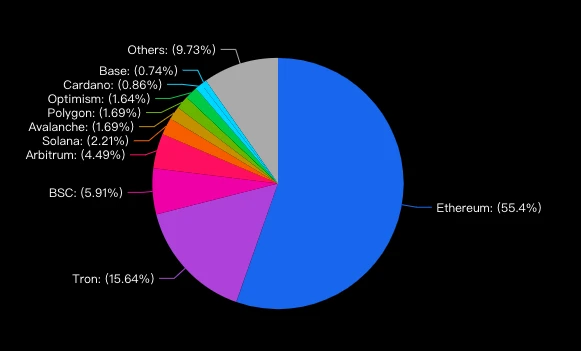
Odaily note: In comparison of mainstream Layer 1/Layer 2 ecological TVL, Arbitrum has ranked among the top five, and Optimism and Base have both ranked in the top ten.
Taking a closer look inside the Layer 2 track, relying on the first-mover advantage,The two representative projects of the Optimismtic-Rollup series, Arbitrum and Optimism, still lead the track in terms of TVL, but they have shown clear differences in their development strategies.
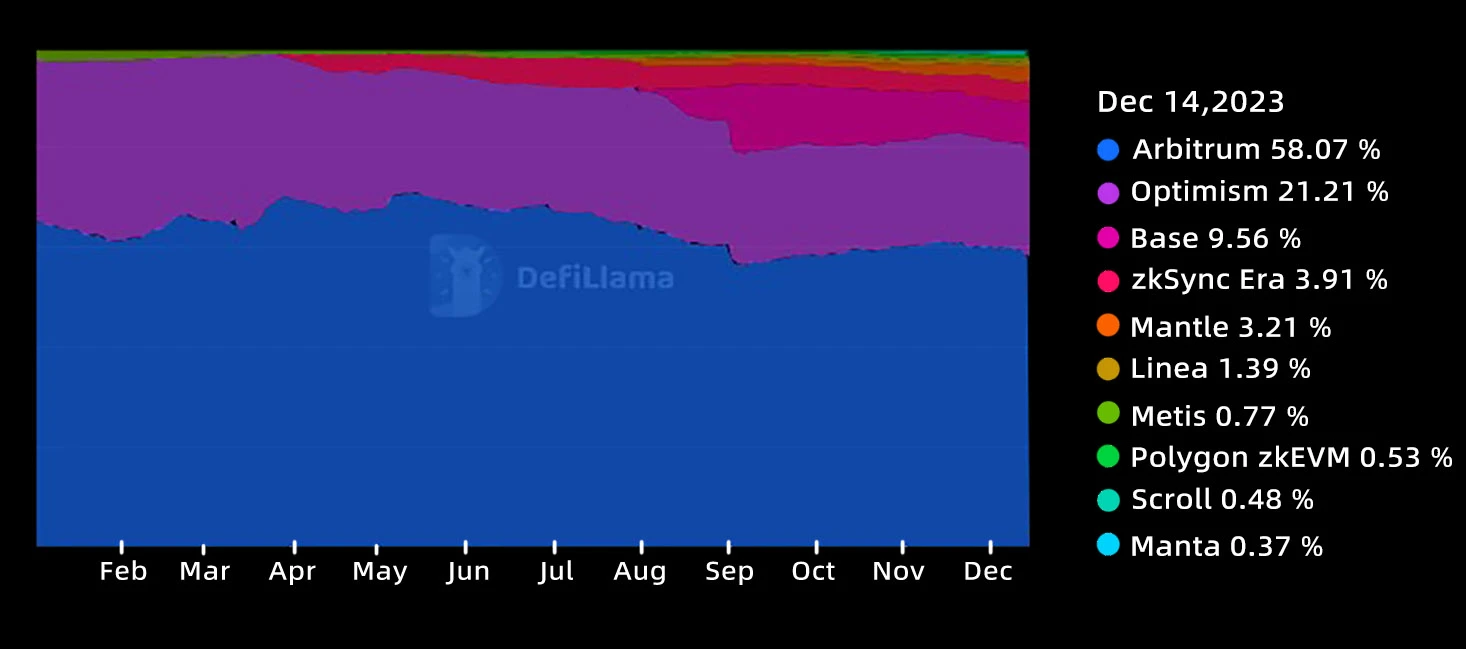
Odaily note: Comparing the changes in the status of the top ten mainstream Layer 2 TVLs during the year, Arbitrum and Optimism still lead the way, and the ZK system began to gradually expand its share around the second half of the year.
Arbitrum launched the governance token ARB in March this year, and immediately launched Layer 2, which was the largest airdrop event in the entire Crypto industry this year. Today, Arbitrum is continuing to stimulate the activity of the main chain through frequent ARB incentives; it is also exploring the possibility of vertical expansion through Arbitrum Orbit; in addition, Arbitrum is also actively building a new development environment Stylus, trying to support more programming languages Support to achieve expansion of EVM.
Optimism continues to promote its horizontal expansion based on the OP Stack architecture, and during the year, it promoted the support of Base, Zora and other strong support. In August, Optimism signed a governance and revenue sharing agreement with Base, which also unveiled the future collaborative operation of the super chain ecosystem - based on the Law of Chain. The framework allows OP to realize the governance effect of the entire ecosystem; the main Chain Optimism expands the ecosystem and promotes decentralization by distributing OP; ecological chains such as Base will use revenue to continuously feed back to the main chain.
It is also worth mentioning that Blast, which currently only has smart contracts but claims to be an automatic interest-generating Layer 2 that will build Optimismtic-Rollup, suddenly disrupted the entire Layer 2 market at the end of the year and relied on the extremely colorful marketing of founder Tieshan CX. Dafa successfully attracted hundreds of millions of dollars in real money and became TVLs third largest Layer 2 after Arbitrum and Optimism.
In terms of ZK-Rollup,The legendary zkEVM is no longer just a phantom that exists in the narrative. zkSync Era, Polygon-zkEVM, Linea, and Scroll have successively launched the main network this year and achieved a certain ecological scale. Starknet has also completed the Quantum Leap upgrade, greatly improving network execution efficiency.
Nowadays, these major networks have become the main battlefields for airdrop hunters. Countless woolists and robots are accumulating interaction data day and night, trying to get a share of future airdrops that are still undetermined.
Another focus issue on Layer 2 in 2023 is,The development of projects such as Celestia and Eigenlayer has promoted discussions on modularity.As some Rollups switched to using third-party networks instead of Ethereum as the data availability layer (DA), what is considered a pure Layer 2 immediately triggered heated discussions in the market.
In this regard, Vitaliks recent articles seem to be quite directional. He first redefined various types of Layer 2, and then proposed that the market explore the potential feasibility of ZK+Plasma. Overtly or covertly, he seems to be deliberately guiding the market away from third-party DAs. plan.
Looking back at the entire year of 2023, one of the more regrettable things is that the Cancun upgrade, which has been brewing for nearly a year, has finally been delayed. However, this has also become our greatest expectation for the development of the Layer 2 track in 2024.
Looking forward to the coming year, the Cancun upgrade is expected to drive Layer 2 to achieve large-scale fee reductions and growth, which may push Layer 2 to usher in a new round of growth peaks.
In addition, the decentralization process of Layer 2 itself in the coming year is also worth looking forward to. This includes whether ZK-Rollup will generally launch tokens and improve the governance system, as well as the development and implementation of the decentralized sequencer (sequencer). process.
The tide is coming. Will 2024 be the year of Layer 2? We will witness it together with a positive attitude.
Layer 1: Market diversity is reduced, and the glory of the “Ethereum Killer” is no longer there
With the gradual improvement of Layer 2, there are already many competing Layer 2 devices on the market. DeFiLlama data shows that Layer 2 currently ranks among the top 10 chains in TVL, and Layer 2 may still occupy more Layer 1 positions in the future.
And against this background, how are the “Ethereum killers” who have been so prominent in the past doing?
In the past year, most emerging Layer 1s have already drifted away from their shining moments. But this does not mean that the Layer 1 market is silent. At present, the former emerging Layer 1 has still seen many changes and innovations in the past year.
At a glance at the Layer 1 track, the most noteworthy event isThe rise of Solana. After the FTX crash, Solana experienced a long period of silence, but was still steadily rebuilding from the ruins.
Solana didnt get off to a great start at the beginning of the year. In February, the Solana network just experienced a fork event. The incident began when a node on the network failed. The glitch resulted in a fork, essentially creating two separate versions of the Solana blockchain. As a result, the nodes in the network cannot reach an agreement, causing consensus to fail. Under this major outage, the processing capacity of the Solana network fell to less than 100 transactions per second.
The network outage lasted for several hours and caused significant disruption to users and developers. Although the developers were able to quickly identify and resolve the issue, the incident still had a negative impact. Panic following the outage raised questions about the platforms scalability and reliability. The confidence and trust of the community was tested, and the incident also caused the price of the SOL token to drop sharply.
Since then, the Solana Foundation and developers have been redoubling their efforts to improve the stability and resiliency of the network. Until Q4 this year, the Solana network ushered in a significant recovery and showed a strong growth trend.
Taking TVL data as an example, DeFiLlama data shows that in the first three quarters of 2023, Solana TVL performance has been relatively stable, hovering around US$300 million. However, after entering Q4, Solana’s TVL has grown rapidly and has now exceeded US$800 million, an increase of approximately 200% compared to before this round of increases.
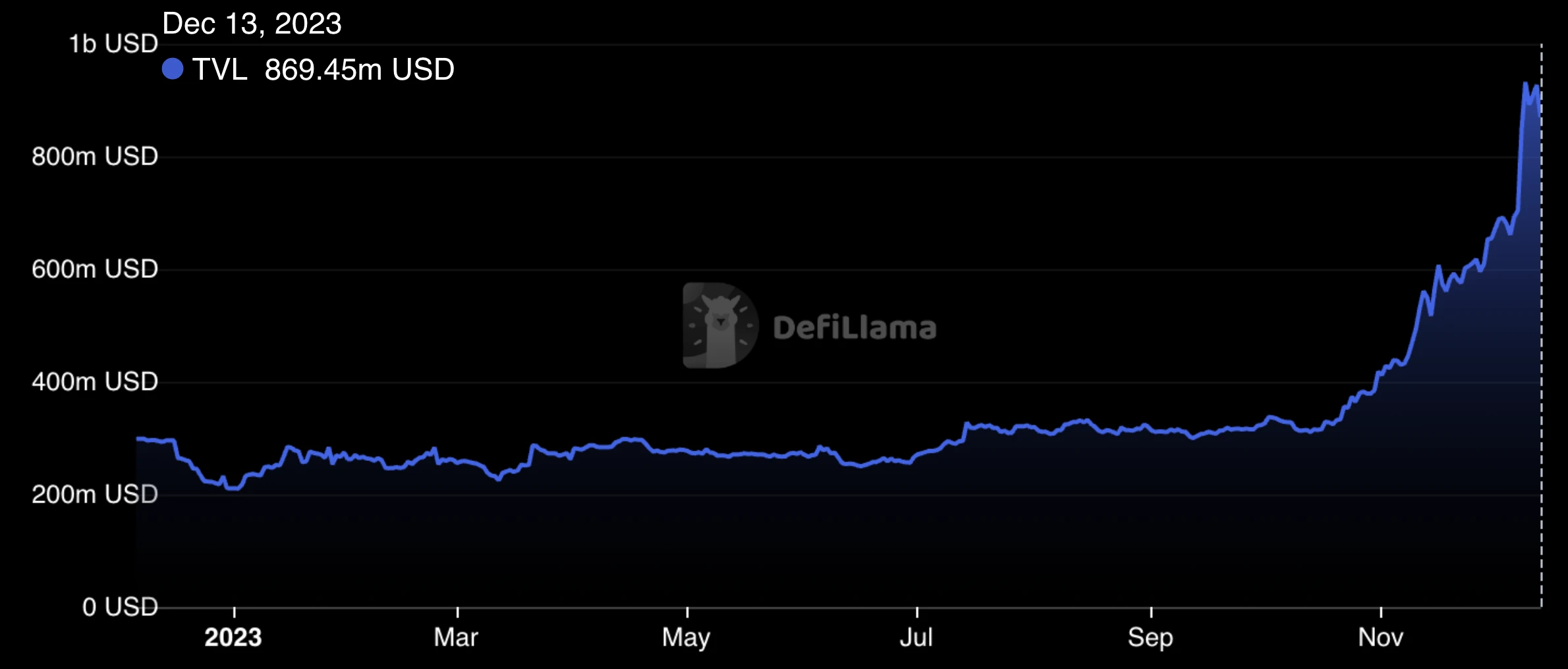
Solana’s DEX trading volume has also risen rapidly. In mid-December, weekly trading volume hit a record high, exceeding $3.7 billion.
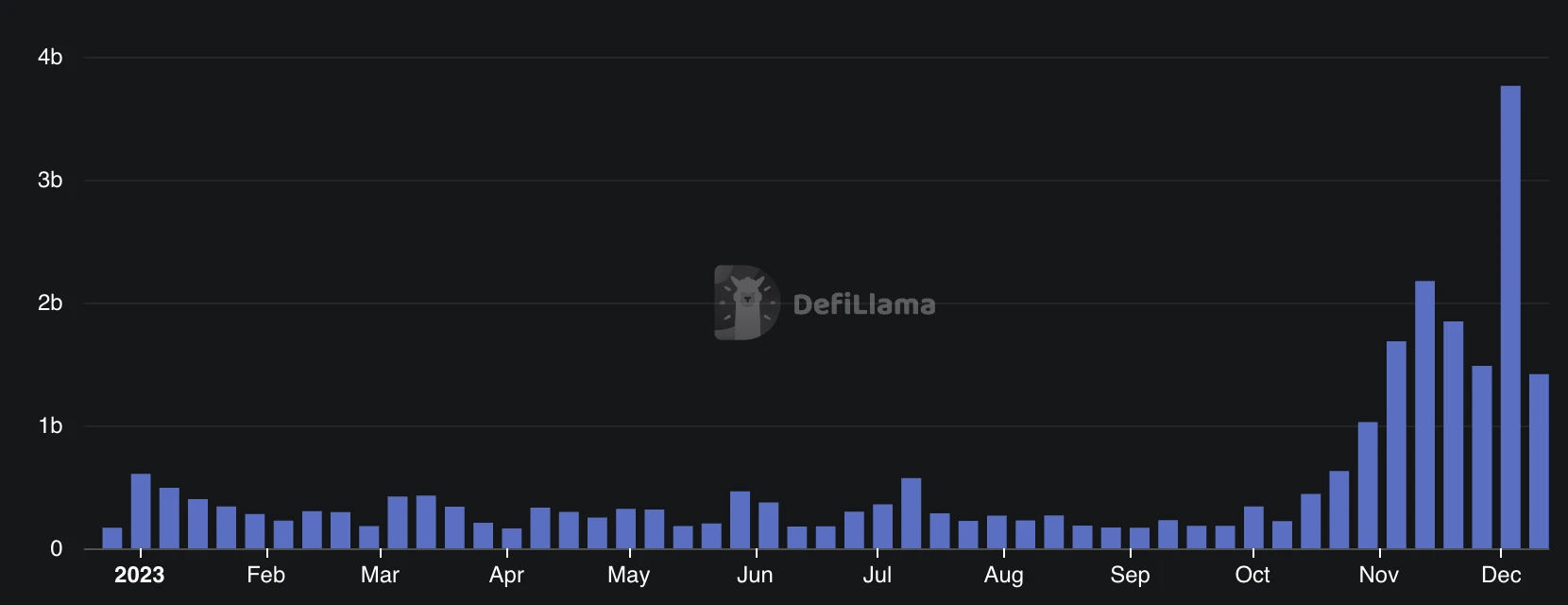
In the crypto market, it is not difficult to achieve temporary gains. Most tokens have had their own highlight moments. The uniqueness of Solana is that this project can actually come back secondary. This is rare for crypto projects.
Among the scattered non-EVM networks on the market,The “Move duo” is also a new public chain that has become very popular this year.
In April, Aptos announced the launch of a delegated staking feature that allows users to delegate staking rights to trusted network validators and receive rewards as individuals.
In May, Sui mainnet was launched. Although it lags behind Aptos, which was launched last year, Suis launch has also achieved good results. Today, when Layer 2 has gradually become the focus of the market and the Layer 1 narrative is fading, what is so special about these two Move-based public chains that have high hopes from a large amount of capital?
Looking back at the story of the founding of Two Heroes, we have to start with Facebook back then. As a social giant, Facebook once intended to enter the field of encryption. They developed the quite original Diem blockchain. But as regulatory failures continued, Diem ultimately failed to achieve the expected results. Diem developers realized that in order not to be constrained by regulation, they had to break away from the original field, so some networks that were closer to the native encryption-Sui and Aptos were born.
Since these two networks are more or less related to Facebooks original Diem, they both inherited the Move language as their smart contract language.
There are big differences between Move and Solidity, and we won’t make any judgments here, but the huge differences make Sui and Aptos a distinctive set of similar products in the market.
DeFiLlama data shows that Sui’s current TVL has reached approximately $150 million, while Aptos’s is approximately $78 million. The on-chain browser shows that the current total number of accounts on the Sui network exceeds 9.11 million, and the current total number of accounts on the Aptos network exceeds 9.9 million.
Overall, Sui Blockchain is off to a great start in 2023. The platform has made progress in both technology and ecosystem, and gained support from investors and developers.
In addition, some other ancient Layer 1 also performed well.
Filecoin is one non-EVM network making big moves this year. In March this year, the Filecoin Virtual Machine (FVM) was successfully launched. Since then, the Filecoin blockchain has been able to support smart contracts and user programmability through FVM.
As a fairly mature network, Filecoin has long been unique in the storage sector. After this FVM update, the introduction of smart contracts gives it computing power. The compatibility of EVM also makes it easier to introduce developers and dApps. This major move sets a new milestone for Filecoin’s future development.
Similar to Filecoin, in the following April, the EOS EVM mainnet Beta version was officially launched. This launch also marks EOS’s ability to achieve interoperability between the Ethereum and EOS ecosystems.
Looking back at non-EVM Layer 1 in 2023, we also found a quite interesting phenomenon.
The popularity of Layer 2 not only drives Ethereum forward, but also has a more or less subtle but long-term impact on the Layer 1 market. Soliditys huge developer ecosystem has allowed more non-EVM-compatible networks to actively embrace the EVM ecosystem. Some niche, non-mainstream networks that are incompatible with EVM seem to be struggling to survive in the market.
The gravity of Ethereum is so strong that other public chains are either actively or passively affected by the Ethereum ecosystem.In November this year, EVM Layer 1 Celo made even more embarrassing moves. cLabs, the main developer of the blockchain, posted the topic Selecting the L2 Protocol Stack Framework on its forum, inviting the community to provide feedback and participate in the discussion.
Celo is trying to reposition itself. The network attempts to develop a Layer 2 network using a mature stack and migrate the ecosystem while inheriting old assets. Within the framework of the plan, priorities will include easy migration, minimal downtime, keeping gas fees low, and Ethereum compatibility.
This also means that when the migration is completed, there will be one less network competing in the Layer 1 world, and users will get a new Layer 2.
Through the changes in the Celo brand ecological niche, it is not difficult to predict that perhaps more and more Layer 1 projects will usher in the countdown to life. For more niche networks, they will either be swallowed up by Ethereum, or they will become completely maverick - just like Solana, Aptos, and Sui.
The living space of Layer 1 like Ethereum has become increasingly narrow.
In that case, thenHow will the large number of high-efficiency, low-gas, and EVM-compatible “Ethereum killers” that emerged in the past develop?
Take Fantom, for example, which was on the rise during the last bull run with back-to-back ACs. Fantom uses Multichain as the main cross-chain bridge of the ecosystem. In July this year, Fantom was in danger due to the Multichain incident. Approximately $118 million in assets were transferred from the Multichain Fantom bridge contract, and the stablecoins issued by the Multichain bridge contract on Fantom experienced significant de-anchoring.
This incident also dealt a heavy blow to Fantom. TVL was in a state of collapse and it is still difficult to recover.
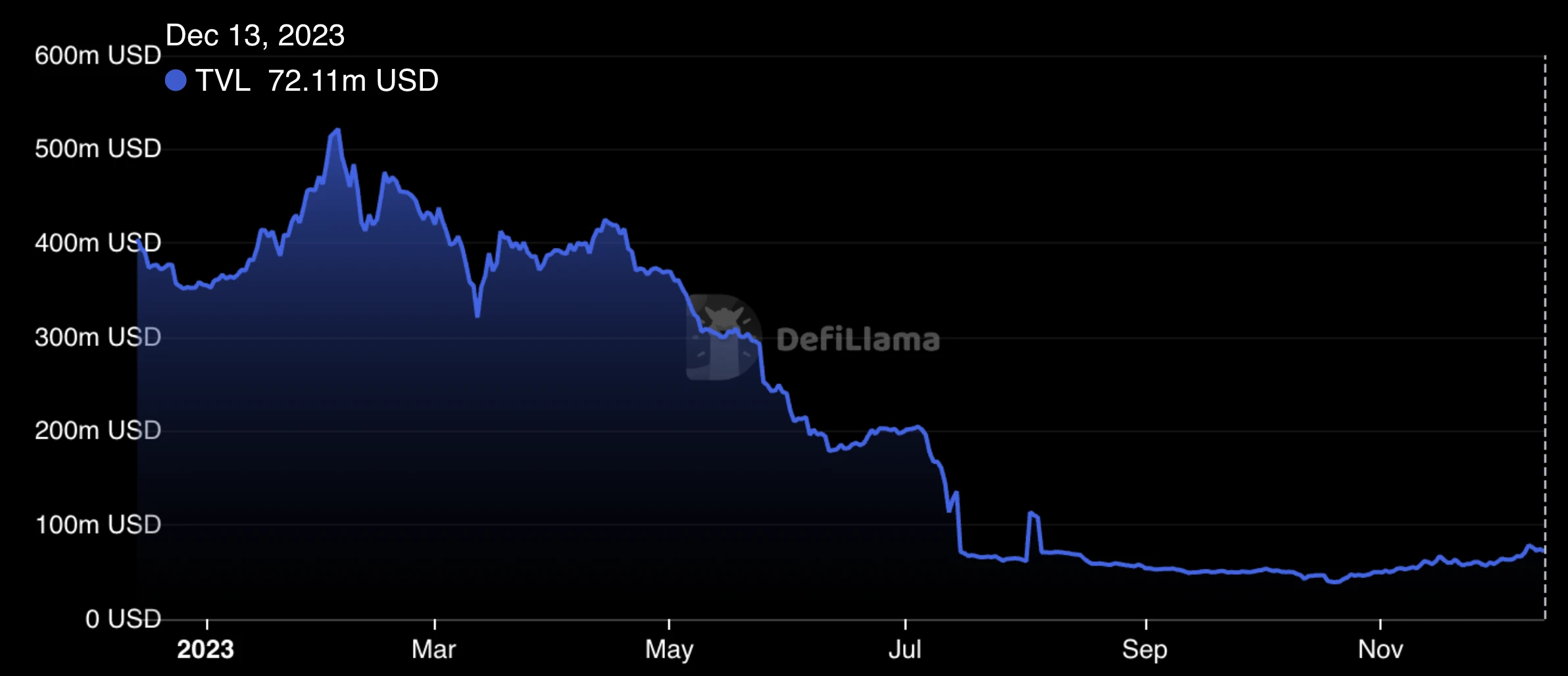
The fate of another Ethereum killer Avalanche is quite different. Despite being in a bear market, Avalanche Networks TVL has not declined significantly so far this year. Interestingly, at the end of the year, the AVAX token rose strongly, and TVL also rose significantly along with it.
In mid-December, AVAX price briefly exceeded $40. Although it is still far from the high point of the last bull market, it has achieved a single-month increase of about 100%. The quarterly gains have been even more dramatic. In Q3 this year, the AVAX token has been hovering at just over $10 for a long time.
Finally, BNB Chain remains the most noteworthy among the EVM networks. Although it is an established public chain, BNB Chain has never stopped innovating. With the launch of BNB Greenfield and opBNB, BNB Chain currently includes computing, storage, Layer, zk and other fields.
Of course, the BNB Chain brand is not just one chain, but a huge family composed of 5 chains. This also makes it unique in the Layer 1 field and occupies a very different ecological niche.
There are so many players in the Layer 1 field that it is difficult to list them all in this article. In addition to the main ones mentioned above, other public chains have also made a lot of progress.
For example, in November, the new CEO of Web3 Foundation, the Polkadot development organization, said that Polkadot is about to undergo a major transformation. The slot auction that has caused market hot spots many times before will become a thing of the past. Polkadot is about to abandon the slot auction of parachains and instead adopt a new mechanism that allows application developers to rent block space as needed. In November, NEAR also announced the launch of the NEAR Data Availability (NEAR DA) layer, a network that provides powerful, cost-effective data availability for ETH rollup and Ethereum developers. NEAR DA reduces costs and improves rollup reliability while maintaining the security of Ethereum. The TON network is also a unique flower that is quite different from other networks. In July, the popularity of the BOT circuit turned Telegram into an alternative encryption application that combines wallet and transaction. Although the tokens people trade are not located on the TON network, they can still trigger peoples imagination about the TON network. In September, Telegram officially announced its cooperation with the TON Foundation. The huge number of users has brought huge room for imagination for the user growth of the TON network.
Looking forward, it is difficult for us to predict the specific future direction of the Layer 1 market. However, it is obvious that the strong rise of Ethereum Layer 2 will further compress the living space of other Layer 1.
For public chains, like Ethereum may increasingly become a constraint to development in the future——Either integrate into the Ethereum ecosystem, or be completely different from it.
As the bull market approaches, will the Layer 1 narrative be completely overtaken by Layer 2 in this cycle? In the coming year 2024, we will jointly witness the answer to this question.
DeFi: Going through the cold winter and heading towards recovery
In our year-end summary of 2022, we described the DeFi track like this - this is obviously not the best year.
The same words still apply to 2023. DeFi Llama data shows that as of early December, the TVL locked in all DeFi protocols on major networks was approximately US$50.8 billion, which is still far from the peak of US$178.54 billion at DeFi Summer in 2021. A gap of more than three times.
